

Modern Chinese Theatres
and Chinese Dance Drama in the
21st Century
Student Name: Jacaranda Zeng
Student Number: 210512715
Dissertation Group: Performance and Architecture
Supervisor: Dr Stella Mygdali
Word Count: 8643
Chinese contemporary dance drama The Eternal Wave by Shanghai Dance Theatre © China Cultural Daily
Table of Contents
Abstract......p4
Acknowledgements......p5
Introduction......p6-p9
Background and Rationale......p6
Research Objectives and Questions......p6
Scope and Limitations......p7
Structure of the Dissertation......p8
Chapter
1 Modern Chinese Theatre Architecture......p10-19
1.1 Key Developments of Theatres Design in the 21st century......p10
1.2 The Undertone of Chinese Traditional Culture on Theatre Architecture in China......p12
1.3 Prominent Chinese Theatres under the Influence of Global Design Trends......p15
1.3.1 National Centre for the Performing Arts (2007), the best Chinese theatre with the highest status......p15
1.3.2 Tianqiao Theatre (founded in 1953, rebuilt in 2001), the first comprehensive theatre since the founding of the People's Republic of China......p16
1.3.3 Shanghai International Dance Centre (2016), the first professional dance centre in Asia......p17
1.3.4 Guangzhou Opera House (2010), one of the three national-level theatres located in Southern China......p18
Chapter 2 Chinese Dance Drama in the 21st Century......p20-31
2.1 Historical Context and Foundations of Chinese Dance Drama......p20
2.1.1 Historical and cultural heritage......p20
2.1.2 Shaping and systematization from 1950s to 2010s......p23
2.1.3 Flourishment since 2010s......p25
2.1.4 Platform period starting in 2020s......p27
2.2 Political, Cultural and Technological Influences on Chinese Dance Drama in the 21st century......p29
2.2.1 Important political directives from government for literary and artistic work in 2012......p29
2.2.2 Cultural and social needs for large-scale theatres and dance drama telling Chinese stories......p29
2.2.3 The Role of Stage Technology in Chinese Dance Drama......p31
Chapter 3 Interplay between Chinese Theatre Architecture and Dance Drama......p33-41
3.1 Emergence of Notable Productions, Choreographers and Dance Troupes, and the Challenges They Face......p33
3.1.1 Prospect and predicament of Chinese dance drama production......p33
3.1.2 Survival and growth of Chinese dance drama troupes and dancers......p36
3.2 Global Influence of Chinese Dance Drama Production......p37
3.3 Case Study of Successful ‘Theatre-Dance Troupes’ Cooperation in China......p37
3.3.1 National Centre for the Performing Arts (2007) + China National Opera and Dance Drama Theatre......p37
3.3.2 Tianqiao Theatre (rebuilt 2001)+ National Ballet of China......p38
3.3.3 Shanghai International Dance Centre (2016) + Shanghai Dance Theatre Co Ltd. ......p39
3.3.4 Guangdong Arts Theatre (2014) + Guangdong Modern Dance Company......p40
Conclusion......p42-43
Key Findings and Insights
Suggestions and Prospects for Chinese Theatre Architecture and Dance Drama
List of Figures......p44
References......p53
Abstract
Theatre architecture in China and Chinese dance drama industry has an inseparable connection. Starting from personal interest of dance drama, theatre and Chinese traditional culture by the author, the dissertation will be written under the rapid development of modern Chinese theatres and dance drama and grave challenges encountered by these two sectors, exploring the close relationship of modern Chinese theatres and dance drama in the 21st century and their influence on each other, as well as discussing future prospects for Chinese theatre architecture and dance drama industry.
Acknowledgements
I would like to say thank you to my parents, Daning and Huali, who has provided me with all the condition to study architecture abroad in the UK, seeing the other side of the world on their behalf.
And a very special gratitude and respect is given to my supervisor Dr. Mygdali, who has been a beacon of light guiding my way of bravely sailing in the vast ocean of academia.
Introduction
Background and Rationale

Based in a small town called Chang 'an in Guangdong, China for over twenty years, the author has obsessed with dancing and explored multiple dance genres from various countries since childhood. Being encouraged by her mother who used to be active as a dancer in the playhouse in her hometown, when the author was a preschool child aged 3, she got in touch with Body Rhyme of Chinese Classical Dance at local library as her first introduction of dance. She learned Xinjiang dance and Mongolian dance, two of the most distinguished Chinese Ethnic Dances, in her kindergarten, and learned Cha-Cha and Rumba at the local cultural centre after class, then performed with her classmates at the town’s cinema & theatre When she was studying in middle school, she learned modern jazz from a local fitness centre after class. During her time in high school, she joined a Korean Dance society and performed with her dance mates for a food festival After she came to the UK, she joined Newcastle University Dance Club and has performed at Tyne Theatre & Opera House and Northern Stage with club members for three years, covering a wide range of dances including hip-hop, classical & modern ballet, contemporary dance, lyrical dance, theatrical jazz and burlesque etc.
The author felt very regretted when she learned that the town’s cinema & theatre she had performed in before had now been abandoned The building used to be a lively venue for various dance drama performances, both domestic and international ones, and it becomes dark and quiet now. The economy of the area where this theatre is located is not as prosperous as it used to be, which may be one of the essential reasons why the theatre cannot continue to operate. As one of the passionate dancers who performed in it, as well as an enthusiast of theatre architecture, the author does not want such vivid fragment of time to be lost in the torrent of Chinese dance performance history. She hopes that she can not only feel the beauty of dance drama performance and theatre through her dancing body, but also record these shining experiences of dancers and development history of Chinese dance drama industry through words. Twenty years of dabbling in the dance industry has made the author deeply understand the connection between theatre architecture and dance performance. Having experienced the western theatrical art, the author was determined to write about theatre and dance drama in the context of her country China.
Research Objectives and Questions
Research objectives of this dissertation is modern Chinese theatres and 21st century’s Chinese dance drama. This dissertation focuses on large-scale modern theatres designed by either domestic or international architects and built in the 21st century in China. Types of Chinese dance drama mentioned in this dissertation
Figure 1. The author in Xinjiang Dance costumes when she was four. © Huali Chen
are Chinese classical dance drama, Chinese ethnic and folk dance drama, Chinese modern and contemporary dance drama, as well as Chinese ballet drama.
Main research question of this dissertation is: what kind of relationship does modern Chinese theatres and Chinese dance drama in the 21st century have and what are their influences on each other?
Scope and Limitations
The reasons why the author aimed at emphasising on the 21st century for both Chinese theatres and dance drama were that, China in the 21st century and China in the 20st century are in completely different levels of development. The turbulent last century for China was a period of formation and framework developments for modern theatres and dance drama. Countless people made various economic and political sacrifices on the path of national development, and the overall development of the cultural industry was so difficult that the achievements of cultural development were not systematic enough for research and reference. The theatres built in the relatively peaceful 21st century and the dance drama created during this time period are very representative and of great significance for dissemination, which is more in line with the cultural needs of modern Chinese people, can better predict the future development direction of Chinese theatres and dance drama, and has more reference significance for the study of cultural industries, literary and artistic works that show today's Chinese characteristics.
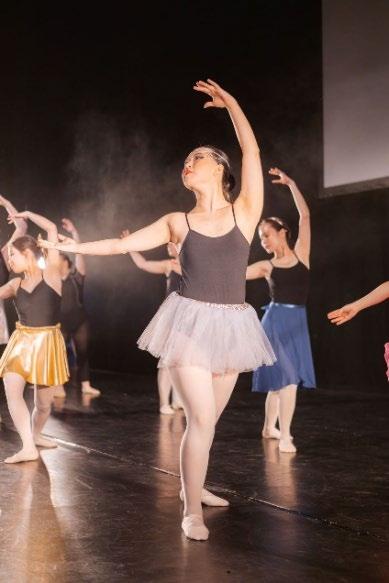
The author as a dancing body herself has personally performed in theatres and has dozens of dance drama watching experience both online and offline. The unparalleled spiritual shock brought by the theatre space deeply influenced the author. The author’s passion for theatre and dance drama is the driving force behind this dissertation and as a tiny architecture student within the vast and far-reaching discipline and industry of architecture, she surveyed the development history of Chinese theatres and dance drama with her eyes, searching for ‘lost pearls’ in the endless sea of Chinese culture. She strives to explore the important connection between architecture and performing arts, looking for representative examples of theatres and dance dramas in China, and stringing these beautiful ‘pearls’ into a ‘necklace’, what she hopes her dissertation will become, for people in and especially outside the Eastern world to appreciate.
Structure of the Dissertation
This dissertation will explore modern Chinese theatre architecture, Chinese dance drama in the 21st century respectively and the relationship between these two sectors by three main chapters.
Chapter 1 Modern Chinese Theatre Architecture will introduce general knowledge of Chinese theatres
Figure 2 The author performing for Newcastle University Dance Club annual show Disco Inferno
at Northern Stage Newcastle © Kieran Zhane
emerged in the 21st century, including introduction to various modern Chinese theatre architecture in the 21st century, Chinese traditional culture shown in modern Chinese theatres nowadays and remarkable examples of Chinese theatre design influenced by global design mainstream.
Chapter 2 Chinese Dance Drama in the 21st century consists of summary of Chinese dance drama evolution from the last century and its different characteristics at various periods and analysis of Chinese dance drama production and performance in the context of political, cultural and stage technology development in recent years.
Chapter 3 Interplay between Chinese Theatre Architecture and Dance Drama contains examination of the current situation of dance drama industry chain containing, discussion from an architectural perspective about the design style of Chinese theatre under the influences of both traditional elements from the history and contemporary characteristics nowadays, demonstration of the efforts made by Chinese dance dramas to adapt to globalisation and exploration of four examples of modern Chinese theatres and its associate dance troupes, ensembles or companies for their successful cooperation
The conclusion will display key findings and insights by the author and prospects for Chinese Theatre Architecture and Dance Drama in a general perspective.
The Author

Figure 3. Map of China with theatres mentioned in this dissertation
Chapter 1 Modern Chinese Theatre Architecture
1.1 Key Developments of Theatres Design in the 21st century

Modern Chinese theatre design, as an indispensable part of China's modernisation journey, has showcased the contemporary style of this century from the inside to outside From an external perspective in particular, the first impression of theatre architecture that brings to people, theatre designers and planners have unique choices in both site selection with its associate environment, and the theatre’s structure and appearance. Firstly, the location of Chinese theatres, which mostly situated at the economic centre of a city, or at the riverside, which is not far away from the city centre, is a comprehensive consideration based on local economic and cultural development The advantages of large population flow, convenient transportation, and developed commerce in a city centre bring a market for theatre business. The emergence of theatres in important areas of Chinese main cities provides an irreplaceable role in cultural dissemination For example, Yulan Grand Theatre (2006) (Figure 4), a theatre designed by Uruguayan-Canadian architect Carlos Ott and located in CBD of Dongguan, is surrounded by the bustling economy of Dongguan city centre. 1Meanwhile, the construction of some theatres located in the suburbs can also quickly make the area a new economic or cultural centre, such as Zhuhai Grand Theatre(2013)(Figure 5) designed by Chinese architect CHEN

<https://carlosott.com/?project=dongguan-yulan-theatre> [accessed 5 November 2024].
1 Carlos Ott Architects, ‘Dongguan Yulan Grand Theatre’, Carlos Ott Architects, n.d.
Figure 4. Yulan Grand Theatre. © Hymchu
Figure 5 Zhuhai Grand Theatre. © Hetian Gu


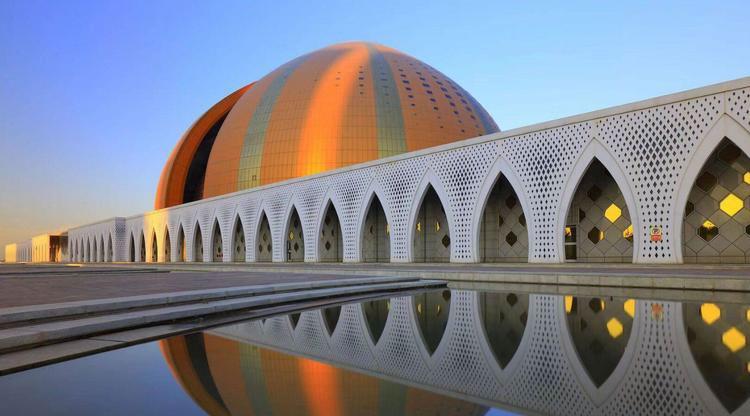
Keshi and situated on Yeli Island at the edge of Zhuhai City 2
Secondly, for building construction, materials and structures such as steel, reinforced concrete, and glass curtain walls are frequently used for fulfilling the massive forms of theatres. For large public buildings like theatres, building stability within decades is an essential condition for their persistence The advancement of industrial technology in China has brought more possibilities for the landing of buildings with complex craftsmanship Moreover, from the appearance of a Chinese theatre, it is often characterised by large volumes, avant-garde architectural styles as an existence with more distinctive features than the surrounding buildings. Compared to relatively similar internal layouts and functions, the appearance of a theatre in China, as an externalisation of the designer's aesthetic and cultural level, is an important factor that is often discussed and evaluated among the many important components in the process of theatre design and implementation Theatres from various corners of China have impressive special-shaped structures, such as Fuzhou Strait Cultural Art Centre (2018)(Figure 6) from southeast China, designed by Finnish architect Pekka Salminen and Chinese architect XU Zongwu, taking the provincial flower jasmine as design prototype 3; Harbin Grand Theatre (2015)(Figure 7) from northeast China, designed by
2 Zhongying Urban Design and Research Institute, ‘Zhuhai Opera House Architectural Design’, Chen Keshi, 2021 <http://www.chenkeshi.com/designs/33.html> [accessed 5 November 2024].
3 Jianjin Gao, ‘Fuzhou Strait Culture and Art Center - What a Beautiful Jasmine Flower’, Baijiahao, 9 July 2023 <https://baijiahao.baidu.com/s?id=1770882095743770047&wfr=spider&for=pc> [accessed 5 November 2024].
Figure 6 Fuzhou Strait Cultural Art Centre © Goodwin, Berthrand and Pano
Figure 7 Harbin Grand Theatre. © Wang Wei
Figure 8 Xinjiang Grand Theatre. © Eiffel

MAD Architects based in Beijing, inspired by local wetlands and snow scenery 4 ; Xinjiang Grand Theatre (2014)(Figure 8) from northwest China, designed by Chinese architect MENG Jianmin, taking snow lotus as design inspiration 5 ; Yangliping Grand Theatre (2019)(Figure 9) in southwest China, an open-air theatre co-designed by Chinese architect ZHU Pei and Chinese folk-dance master YANG Liping, etc. 6
1.2 The Undertone of Chinese Traditional Culture on Theatre Architecture in China
If comparing China's cultural industry to a golden phoenix that has been baptised by the flow of history for thousands of years, then in author’s eyes, theatres in China are like the most beautiful feathers on the head of this golden phoenix In the 21st century, where modern theatre construction in China is rapidly emerging like the growth of bamboo shoots, theatre designers often choose to adapt to local conditions, incorporating elements with traditional Chinese flavour into the building's characteristics.
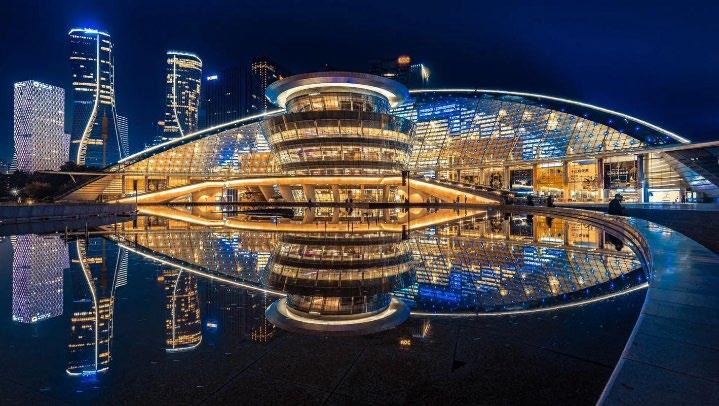
Hangzhou Grand Theatre (2004)(Figure 10) as a prime cultural facility in Zhejiang Province located beside Qiantang River, was designed by Uruguayan-Canadian architect Carlos Ott, who also designed Yulan Grand Theatre in Dongguan. 7 It features double curved glazed facades and titanium roof and has the design concept of ‘pearl in oyster’, 8 which looks similar to Beijing ‘天坛’ (Temple of Heaven) at first glance in author’s eyes, making herself immerse in the solemn atmosphere of Chinese history As early as 2004, WANG Guangrong, the
4 Fang Yin, ‘Quiet Listening | The 314th National Project: The Artistic "Snow Mountain" Standing by the Songhua River - Harbin Grand Theatre’, Weixin, 22 May 2022 <https://mp.weixin.qq.com/s?__biz=MzIwMDI4OTM5Mw==&mid=2653332292&idx=1&sn=0fa8256a46afc07a64bf6be4abbba438&chksm=8d2d7e5aba5 af74cc8d2557ab65ec7d686bb6d35c9a5a9a71341d0207239e15f00d0b8c1810c&scene=27> [accessed 5 November 2024].
5 Wei Jing, ‘Xinjiang Grand Theatre’, Meipian, 10 May 2016 <https://www.meipian.cn/1t44817> [accessed 5 November 2024].
6 Buzhi Xingzou, ‘Dali Old City Yang Liping Grand Theatre’, Baijiahao, 11 May 2024 <https://baijiahao.baidu.com/s?id=1798747852674445829&wfr=spider&for=pc> [accessed 5 November 2024].
7 Carlos Ott Architects, ‘Hangzhou Grand Theatre’, Carlos Ott Architects, n.d. <https://carlosott.com/?project=hangzhou-grand-theatre> [accessed 5 November 2024].
8 Ibid.
Figure 9 Yangliping Grand Theatre. © Yang Jiyuan
Figure 10 Hangzhou Grand Theatre. © Commander of Eastern Wu Navy
then Deputy Secretary General of the Municipal Government, said Hangzhou Grand Theatre is like a ‘shiny gem ’ surrounded by the ‘crescent moon’, which was the white light strip reflecting on the water surface by double curved glazed facades of the Theatre. 9 There are various interpretations of the shape of Hangzhou Grand Theatre, but many local residents feel it resembles a moon embracing a pearl, both rising from the surface of the Qiantang River 10 , just like an old Chinese verse saying ‘沧海月明珠有泪’ (pearl-like bright moon
shedding tears over the sea), evoking the reflection on the passage of time written by ancient Chinese poet LI Shangyin 11

Japanese Architect Tadao Ando brought his favourite fair-faced concrete and original timber design to Shanghai Poly Grand Theatre (2014) (Figure 11). 12 As Ando’s second design project in China, Shanghai Poly Grand Theatre has been ingeniously designed as a semi indoor space, connecting the audience seats inside the theatre to create a prospect of the integration of Yuanxiang Lake and the theatre itself. 13 The Theatre includes four main performance venues, namely 1466-seated large theatre, 400-seated small theatre, as well as two outdoor theatres: the water feature theatre and the rooftop theatre. 14 Five kaleidoscope structures are embedded in the square shell, interweaving countless straight and curved lines, therefore, when light passes through the middle, geometric shapes are presented in a three-dimensional manner. 15 Natural elements such as wind, light, and water have been incorporated into the architecture, creating a place for people to stay, communicate, and blend with nature in and around the Theatre. 16 It has also given birth to unexpectedly
9 Fengying Wang, ‘Last night Hangzhou Grand Theatre was like a bright pearl coming out of water’, Hangzhou Bureau of Planning and Natural Resources, 11 August 2004 <http://ghzy.hangzhou.gov.cn/art/2004/8/11/art_1228962612_40245300.html> [accessed 5 November 2024].
10 Shenzhen Municipal Public Works Bureau, ‘Hangzhou Grand Theatre | A Silver Moon by the Qiantang River’, Weixin, 11 August 2021 <https://mp.weixin.qq.com/s?__biz=MzAxNjE3MzExNA==&mid=2649978364&idx=1&sn=6eedd25e1f911fc4fae1db0ab13d041f&chksm=83ff04a9b4888 dbfddff337034bc8fcd65661e6e4831cc51ba00e7b22243fcbdf662025ac92b&scene=27> [accessed 6 November 2024].
11 ‘Translation and Annotations of Ornamented Zinther’, Ancient Poetry and Literature Web, 2024 <https://www.gushiwen.cn/mingju/juv.aspx?id=0933ba8f30f8> [accessed 6 November 2024].
12 Poly Theatre, ‘Shanghai Poly Grand Theatre’, Poly Theatre, n.d. <https://shpgt.polyt.cn/#/NavigationDetail?id=15170000000000858&name=关于我们> [accessed 6 November 2024].
13 Ibid.
14 Ibid.
15 Shanghai WOW!, ‘Steel reinforced concrete poet "Tadao Ando, 7 Art Buildings in the Magic City’, NetEase, 28 April 2018 <https://www.163.com/dy/article/DGFM0A5B05228770.html> [accessed 6 November 2024].
16 Yingyu He, ‘Tadao Ando in China’, Xinmin Weekly, 20 April 2021 <https://www.xinminweekly.com.cn/wenhua/2021/04/20/15791.html> [accessed 6 November 2024].
Figure 11 Shanghai Poly Grand Theatre. ©Richard Lu
rich and colourful public spaces, shining like a ‘cultural kaleidoscope’ 17 The use of square and circular shapes in the architectural form reminds the author of the simple and unadorned worldview of ancient China, where ‘天圆 地方’ (the sky is round and the earth is square)

Nantong Grand Theatre (2020) (Figure 12)was the last building in China designed by French Architect Paul Andreu, who also designed National Centre for the Performing Arts in Beijing 18It features the vertically locked metal roof system introduced from abroad, consisting of perforated aluminium panels with irregular curved surfaces 19 Under each five curve surfaces of the Theatre are Youth Activities Centre, Playhouse, Grand Opera House, Concert Hall and Creative Centre respectively. 20 With design inspiration from a verse
‘钧天广乐出琴山,泛舟涟漪在珠水’ ( Music as vast as the sky emerges from Qin Mountain when boating with ripples on Pearl River), the Theatre looks like a piece of frozen music. 21 The flowing shape of the Theatre harmoniously matches the meandering lake landscape around it, and the exaggerated architectural lines bring vitality to the peaceful lake water, achieving an excellent balance between movement and stillness
17 Zhushengge, ‘Ten years have passed, and the Shanghai Poly Grand Theatre is still stunning’, Baijiahao, 19 June 2024 <https://baijiahao.baidu.com/s?id=1802240379220908419&wfr=spider&for=pc> [accessed 6 November 2024].
18 ‘Nantong Grand Theatre’, Yankon, 2020 <https://yankon.com/case_1300.html> [accessed 6 November 2024].
19 Renmin Zixun, ‘Nantong Grand Theatre welcomes its first blooming, and China Construction Eighth Engineering Division helps create a new cultural calling card for Nantong!’, Baijiahao, 20 May 2021 <https://baijiahao.baidu.com/s?id=1700273109365466917&wfr=spider&for=pc> [accessed 6 November 2024].
20 GA Global Architecture, ‘The fifth largest theatre in China - Nantong Grand Theatre, designed with the meaning of ‘Qinshan Zhushui’, NetEase, 19 August 2020 <https://www.163.com/dy/article/FKE298940514ETGI.html> [accessed 6 November 2024].
21 Ibid.
Figure 12 Nantong Grand Theatre. ©Shizhi Culture
1.3 Prominent Chinese Theatres under the Influence of Global Design Trends
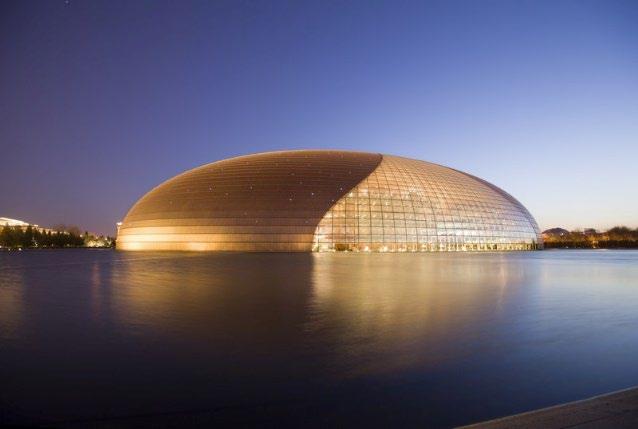

Science and Education Specialized Committee
1.3.1 National Centre for the Performing Arts (2007), the best Chinese theatre with the highest status
Since established in 2007, National Centre for the Performing Arts has been a renowned performance venue and cultural landmark based in the centre of Beijing. 22 As a national-level theatre, it is different from other theatres that operate according to the market and is positioned as a public welfare institution, with most of the operating costs subsidised by the government. 23
Designed by French architect Paul Andreu, the architecture is a semielliptical eggshell shaped structure made of steel in a soft colour of titanium metal, which looks like a huge dewdrop floating on the lake from a distance. 24
The Centre, featuring a 2081-seat opera house, welcomes provincial dance troupes, dance institutes and individual talents from all over the world. 25
Members from China National Dance Troupe and Beijing Dance Academy Youth Dance Troupe constantly bring their performance to the Centre. 26
22 China National Centre for the Performing Arts, ‘The NCPA’, China National Centre for the Performing Arts, 2024 <https://en.chncpa.org/aboutus/> [accessed 26 September 2024].
23 China National Centre for the Performing Arts, ‘The NCPA’.
24 Fusong Culture and Technology Group, ‘Classic Case | National Centre for the Performing Arts - a milestone in the construction of Chinese theatres’, Baijiahao, 16 August 2024 <https://baijiahao.baidu.com/s?id=1807506755355875531&wfr=spider&for=pc> [accessed 27 September 2024].
25 Ibid.
26 Ibid.
Figure 13 National Centre for the Performing Arts. © Yanmama
Figure 14. Opera House, National Centre for the Performing Arts. © Chinese Oriental Culture Research Association
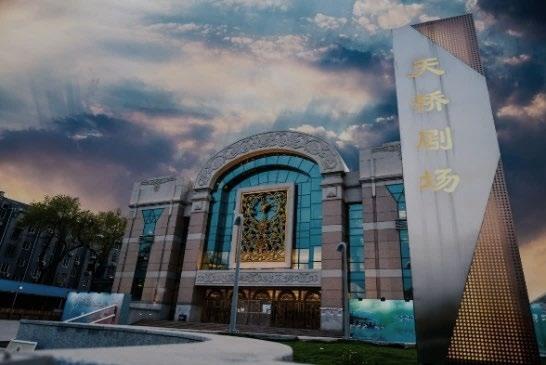

1.3.2 Tianqiao Theatre (founded in 1953, rebuilt in 2001), the first comprehensive theatre since the founding of the People's Republic of China
Founded in 1953 and rebuilt in 2001, Tianqiao Theatre has been the first comprehensive theatre built in China after the founding of the People's Republic of China. 27 It is located at the southern end of Qianmen Street on the central axis of Beijing and is known as a brilliant cultural pearl in the southern part of the capital city Beijing in the 21st century 28 The auditorium of Tianqiao Theatre contains 1215 seats. 29
The theatre has signed an exclusive contract with National Ballet of China, a well-known Chinese ballet company, to provide a long-term performance venue, promotion, and operation for the company. 30 Moreover, the theatre has successfully held four sessions of the China International Ballet Performance Season, inviting domestic and foreign artists and performance groups to participate, which not only provides a platform for cultural exchange between Chinese and foreign artists, but also allows Chinese ballet to give its own voice. 31
27 Xicheng District People's Government of Beijing Municipality, ‘Tianqiao Theatre’, Xicheng District People's Government of Beijing Municipality, 9 May 2024 <https://www.bjxch.gov.cn/zt/jytq/xxxq/pnidpv952342.html> [accessed 25 October 2024].
28 Ibid.
29 The 5th National Ethnic Minority Literature and Art Exhibition Official, ‘Tianqiao Theatre’, National Ethnic Affairs Commission Government Website, 28 July 2016 <https://www.neac.gov.cn/seac/c100627/201607/1096177.shtml> [accessed 25 October 2024].
30 Ibid.
31 Tianqiao Theatre, ‘Theatre Overview’, Tianqiao Theatre, n.d. <https://www.tianqiaojuyuan.com/overview.html> [accessed 25 October 2024].
Figure 15 Tianqiao Theatre. © Xicheng District People's Government of Beijing Municipality
Figure 16 Auditorium of Tianqiao Theatre. © Wenyizhisheng
1.3.3 Shanghai International Dance Centre (2016), the first professional dance centre in Asia



Being home to Shanghai Song and Dance Troupe, Shanghai Ballet, Shanghai Theatre Academy Dance College and Shanghai Dance School, Shanghai International Dance Centre, designed by STUDIOS Architecture, contains a large theatre with 1080 seats and a 300-seat rehearsal hall. 32 This Centre has mature support programs for dance artists, including associate artists, dancers who have long-term partnerships with theatres, ballet performers, or choreographers 33 ; Theatre commission refers to the introduction of dance dramas or performances by dance troupes from outside the Centre 34 ; The Youth Incubation Platform provides resources, funding, promotion, and exchange opportunities for young dancers, promoting the internationalisation of Chinese dance performances and Chinese dance dramas. 35
Various famous dance drama produced by local dance units such as classical dance drama, such as Farewell My Concubine (2003), contemporary dance drama Crested Ibises (2014) and modern ballet dance drama A Sign of Love (2006) are often performed in the Centre. 36 Having combination between a dance theatre and dance troupes has proved an effective way to make full use of local theatre sources and bring profits to local theatres and dance troupes themselves, achieving a win-win situation.
32 Shanghai International Dance Center, ‘The Grand Theater’, Shanghai International Dance Center, 2014 [accessed 27 September 2024].
33 Ibid.
34 Ibid.
35 Ibid.
36 Ibid.
Figure 17 Shanghai International Dance Centre. © Shanghai International Dance Centre.
Figure 18 Grand Theatre of Shanghai International Dance Centre. © Shanghai International Dance Centre Development Foundation
1.3.4 Guangzhou Opera House (2010), one of the three national-level theatres located in Southern China
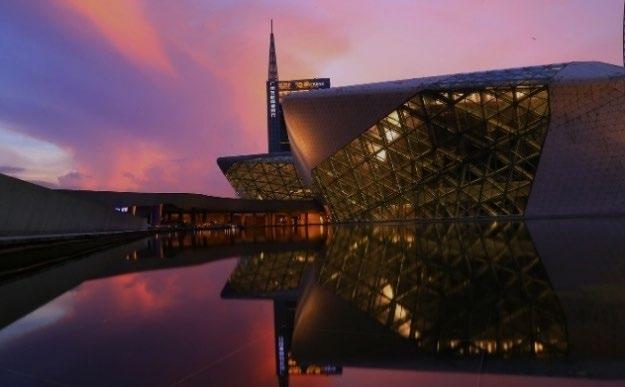

Located at the CBD of Guangzhou, the capital city of Guangdong, Guangzhou Opera House was destined to become a new landmark before it was even built 37 by Zaha Hadid as her first project in China and officially opened in 2010, the Opera House has a 1687-seat opera hall, a 350-seat experimental theatre, and three rehearsal halls with different functions. 38
As the largest and provincially recognized grand theatre, Guangzhou Opera House has attracted talented dance troupes in the area and their production, including Guangdong Song and Dance Theatre and Guangdong Modern Dance Company with their dance drama performances, although these two units have their own base, which are Guangdong Arts Theatre 39 and Guangdong Modern Dance Company Black Box Theatre respectively. 40
In summary, large-scale Chinese theatres mentioned above are distinguished by their remarkable architectural design that harmoniously blends modern aesthetics with traditional elements, positioning them as cultural landmarks. These performing art spaces are outfitted with high-end technology, featuring excellent acoustics, advanced lighting systems, and adaptable stages that accommodate a wide range of performances from traditional opera performance to contemporary dance drama productions. With their significant seating capacities, these theatres are essential for highlighting regional arts and fostering international cultural
37 Shanghai International Dance Center, ‘The Grand Theater’, Shanghai International Dance Center, 2014 [accessed 27 September 2024].
38 Guangzhou Opera House, ‘Theatre Introduction’, Guangzhou Opera House, 2024 <https://www.gzdjy.org/intro.html> [accessed 27 September 2024].
39 Guangdong Song and Dance Theater, ‘Performance Review | "Traveling to Lingnan" - A Small Boutique Evening Party in the Guangdong Hong Kong Macao Greater Bay Area Successfully Ended!’, Guangdong Song and Dance Theater, 13 October 2023 <http://www.gdgwjy.com/news/index_34.html> [accessed 27 September 2024].
40 Guangdong Modern Dance Company, ‘Guangdong Modern Dance Company Black Box Theatre’, Guangdong Modern Dance Company, 2024 <http://gdmdc.com/zh-cn/thetheatre/> [accessed 27 September 2024].
Figure 20. Interior of Guangzhou Opera House. © Guangzhou Opera House
Figure 19 Guangzhou Opera House © GUO Feiqiu
exchanges. They offer multifunctional spaces such as expansive auditoriums, black-box theatres, and space for exhibition, making them an ideal venue for dancers to perform, for people in academia to study and do research, and for audience to appreciate Chinese dance drama
Chapter 2 Chinese Dance Drama in the 21st Century



2.1 Historical Context and Foundations of Chinese Dance Drama
2.1.1 Historical and cultural heritage
The concept of Chinese dance ( 中国舞 ) includes ‘Chinese classical dance’ (中国古典舞) and ‘Chinese ethnic and folk dance’ (中国民族
民间 舞 ) 41 The establishment of Beijing Dance School (predecessor of Beijing Dance Academy), the first ever professional dance school in the People's Republic of China, has standardised the teaching methods and techniques of Chinese dance, while research of Chinese dance by scholars, choreographers and dance educators across the country started to be systematised. 42
Chinese classical dance (Figure 21), as an important branch of Chinese dance representing Chinese cultural characteristics, is formed by refining essence from Chinese traditional martial arts, acrobatics and opera. It consists of classical dance body rhyme ( 古典舞身韵) , Han Tang classical dance (汉唐舞), Dunhuang classical dance (敦煌古典舞)and Kun dance (昆舞). 43 Chinese ethnic dance(Figure 22) includes dances from the 56 officially recognised Chinese ethnic groups and focuses on ethnic minority groups,the most famous ones include Xinjiang dance (Uyghur dance), Korean dance, Tibetan dance and Mongolian dance. 44 Chinese folk dance focuses on folk dance by the Han nationality, the only
41 Emily Wilcox, Revolutionary Bodies: Chinese Dance and the Socialist Legacy (University of California Press, 2019), p. 44 <https://www.jstor.org/stable/j.ctv941vcs.7?seq=32> [accessed 9 November 2024].
42 Beijing Dance Academy, ‘School Profile’, Beijing Dance Academy, n.d. <https://www.bda.edu.cn/xygk/xyjj/index.htm> [accessed 9 November 2024].
43 Ping Yu, A Comprehensive Discussion on the Construction of Chinese Classical Dance Discipline (Shanghai Music Press, 2017), pp 8-15
44 Minzu University of China, ‘Collage Profile’, Minzu University of China, Collage of Dance, 2021 <https://wd.muc.edu.cn/xygk/xyjj.htm> [accessed 10 November 2024].
Figure 21. Chinese classical dance. © Shuanghua Qiulu
Figure 22 One of the Chinese ethnic dancesUyghur dance by Dancer Guli Mina © HE Ming
Figure 23. Chinese modern dance by Dancer XIE Xin © LIAO Yang
Chinese ethnic majority group, and traditional dance from rural area in China representing unique regional culture. 45
Apart from these two vernacular dance genres, Chinese modern dance ( 中国 现代 舞 ) (Figure 23), Chinese contemporary dance (中国当代舞)and Chinese Ballet (中国芭蕾)have emerged and been developed from western dance culture ,but preserved strong Chinese characteristics, combining traditional Chinese opera with music played on Chinese folk instruments, creating vernacular dance drama and performance based on Chinese literature and life to tell Chinese own stories. 46
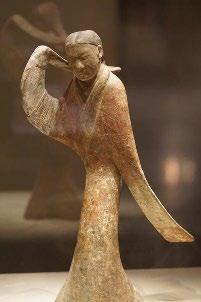
Before being officially named an official dance form, Chinese dance had its origins in various ancient dynasties The origin of Chinese dance history dates back to Shang Dynasty (商朝, 1600-1046 BCE) and Zhou Dynasty (周, 1046-256 BCE) of ancient China, when dances were mainly ceremonial, related to religious rituals, court rituals, and social functions. 47 Early dance in China often involved symbolic gestures and movements aimed at connecting people with the spiritual world, celebrating harvests, or commemorating ancestors. 48 By Han Dynasty (汉朝, 206 BCE-220CE),art form like Baixi(百戏, general term for folk performing arts) emerged Artworks, murals, and written records from Han Dynasty can showcase traces of court dance and folk dance. 49 (Figure 24)
Tang Dynasty( 唐 朝 , 618-907CE) is considered as a golden age for Chinese traditional arts. 50 Emperor Tang Xuanzong established Liyuan( 梨园 , an institution for imperial opera troupe), having a profound impact on Chinese performing arts industry nowadays(Figure 25) . 51 Song Dynasty (宋朝, 960-1279 CE) further developed Chinese court dance and folk dance, giving rise to genres such as Kunqu Opera, which later became the reference prototype of Kun Dance , a type of Chinese
45 Fresh Graduate Web, ‘Basic knowledge of folk dances of various ethnic groups’, Fresh Graduate Web, 15 March 2023 <https://www.yjbys.com/edu/minjianwu/377482.html> [accessed 10 November 2024].
46 Chunru Xing, Overview of the Development of Chinese Dance (Liaohai Press, 2015), p. 8
47 Chunru Xing, Overview of the Development of Chinese Dance (Liaohai Press, 2015), p. 9.
48 Ibid.
49 Ibid.
50 Shandong University of Technology, ‘The Past and Present of Chinese Classical Dance’, Shandong University of Technology, n.d. <https://etcnew.sdut.edu.cn/meol/analytics/resPdfShow.do?resId=617808> [accessed 9 November 2024].
51 National Academy of Chinese Theatre Arts, ‘Profile’, National Academy of Chinese Theatre Arts, 2024 <https://www.nacta.edu.cn/xygk/xyjj/index.htm> [accessed 10 November 2024].
Figure 24 Han Dynasty music and dance figurines © Gaozhan Qijianyou
Classical Dance. 52 Through the Yuan(元朝, 1271-1368CE), Ming(明朝, 1368-1644CE), and Qing(清朝, 1644-1912CE) dynasties, Chinese classical opera, including Peking Opera, has integrated dance elements of performance, formulaic movements, and martial arts, and has developed into a very mature and well-known art form, providing a solid foundation for later development of various genres of Chinese dance. 53
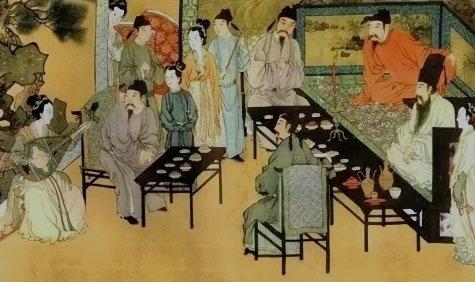
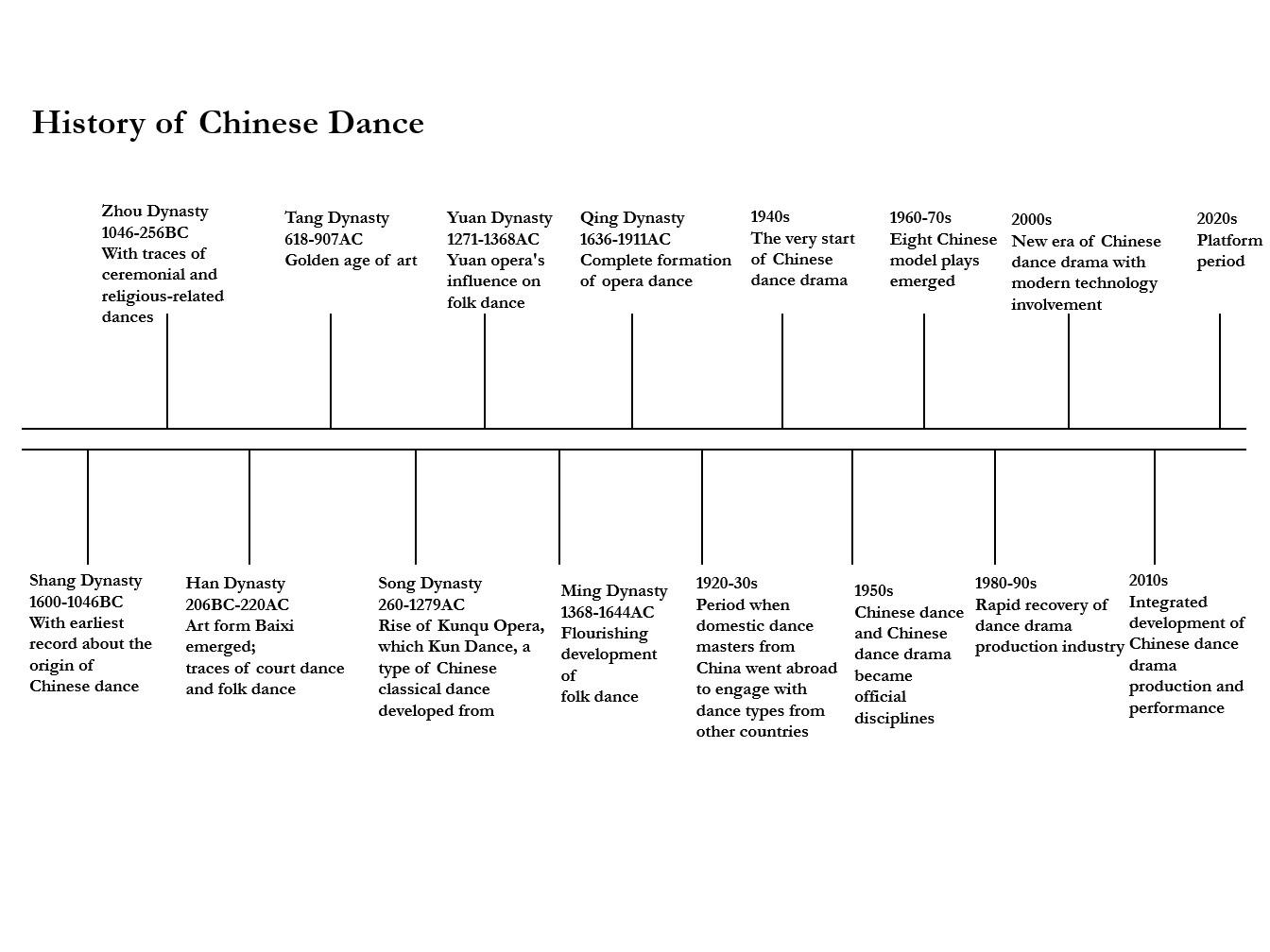
52 Dong Jiang, New Theory of Classical Dance: Classical Dance Volume (Shanghai Music Press, 2022), p. 90.
53 Ibid.
Figure 25. Tang Dynasty Liyuan. © Unknown
Figure 26. History of Chinese dance. ©The Author
2.1.2 Shaping and systematization from 1950s to 2010s
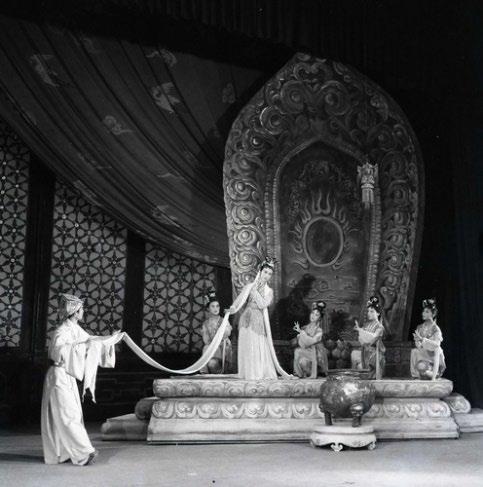
1950s was when Chinese dance drama truly started to be developed. 54 Before Chinese dance ( 中国 舞) and Chinese dance drama ( 中国的舞剧) became distinct performing art forms, pioneers in Chinese dance industry actively explore the development of narrative dance dramas. 55 Since 1950s , artists like DAI Ailian (first principal of Beijing Dance Academy and National Ballet of China) and WU Xiaobang (first president of China Dance Association; teacher of later Folk Dance Master YANG Liping) organised the first batch of formal courses and choreographed some of China's earliest dance dramas 56 The first grand Folk Dance Drama produced in China was Lotus Lantern (宝莲灯,1959) (Figure
27) by China National Opera & Dance Drama Theatre (中国歌剧舞剧院), the largest, most diverse, and oldest national-level art theatre in China. 57 Modern ballet dance drama The Red Detachment of Women (红色娘子军, 1964) and The White-Haired Girl ( 白毛女, 1964) became two of the eight model opera during the Cultural Revolution (1966-1976) as classic examples for telling Chinese revolutionary tales. 58

In late 1970s, China underwent significant social and cultural changes after cultural revolution, and there was a resurgence of creative freedom in the arts. 59 Various regions across the country are competing to launch large-scale dance dramas, which have greatly expanded their creative horizons and expressive themes. Chinese dance dramas have shown a
54 Zhengyi Li and Xin Li, Exploration: The Creation Process of Chinese Classical Dance (Social Science Academic Press, 2017), pp.19-20.
55 Ibid.
56 Beijing Dance Academy, ‘Review of School History’, Beijing Dance Academy, 2024 <https://www.bda.edu.cn/xygk/yshm/index.htm> [accessed 10 November 2024].
57 China National Opera & Dance Drama Theatre, ‘Dance Drama Collection’, China National Opera & Dance Drama Theatre, 2024 <http://www.cnoddt.com/jmjj.aspx?clmId=10> [accessed 10 November 2024].
58 National Ballet of China, ‘Dance Drama’, National Ballet of China, 2020 <https://www.nbc.cn/about_repertoire_all-3401.html> [accessed 10 November 2024].
59 Comprehensive Department of Institutional Reform National Development and Reform Commission, ‘The great achievements and profound enlightenment of reform and opening up’, The Central People's Government of the People's Republic of China, 28 December 2023 <https://www.gov.cn/yaowen/liebiao/202312/content_6920814.htm> [accessed 10 November 2024].
Figure 27. Folk dance drama Lotus Lantern. © China National Opera & Dance Drama Theatre
Figure 28. Folk dance drama Silk Road Flower Rain. © LIU Changzhong

diversified development trend through bold absorption and reference There were famous folk dance drama like Silk Road Flower Rain (丝路花雨,1979) (Figure 28) emerging and becoming famous across the country, which was created using the world-renowned Silk Road and Dunhuang murals as materials 60 Another dance work worth mentioning during that time is the first Han-Tang Classical Dance Drama Dancer of The Tongque Stage (铜雀伎,1985) was produced by China National Opera & Dance Drama Theatre, narrating the tragic love story of a dancer and a drummer in the feudal society of the Three Kingdoms period (三国时期,200-280 CE) 61

During the 21st century, Chinese dance drama has achieved significant growth in artistic maturity, thematic diversity, and international recognition, seeking a balance between tradition and modernisation Chinese modern ballet dance drama Raise the Red Lantern (大红灯笼高高挂,2001)(Figure 29) was a successful cooperation between National Ballet of China and a famous Chinese film director ZHANG Yimou. 62 This drama, a great success when it premiered at Tianqiao Theatre, used Chinese Peking Opera, folk songs, folk melodies, and folk percussion music, employed modern musical techniques, and drew on the techniques of Chinese shadow puppetry to tell the love stories of families in deep courtyards in northern China. 63 Meanwhile, in terms of Chinese folk dance drama, Dynamic Yunnan ( 云南映像 , 2003) (Figure 30), showcasing the natural scenery and culture of Southwest China, is a masterpiece of art starring YANG Liping, a renowned Chinese folk dance artist famous in China since 1970s, as the artistic director and dancer in this dance drama. 64 Artist YANG, famous for
60 Gansu Provincial Department of Culture and Tourism, ‘45 Years of 'Silk Road Flower Rain' Lasts for a Long Time but Remains New’, Gansu Provincial Department of Culture and Tourism, 5 July 2024 <https://wlt.gansu.gov.cn/wlt/c108547/202407/173945996.shtml> [accessed 10 November 2024].
61 China National Opera & Dance Drama Theatre, ‘Dancer of the Tongque Stage’, China National Opera & Dance Drama Theatre, 4 June 2015 <http://www.cnoddt.com/cont.aspx?newsId=2039&TId=10> [accessed 10 November 2024].
62 National Ballet of China, ‘Raise the Red Lantern’, National Ballet of China, 2020 <https://www.nbc.cn/img_content-3443-10668.html> [accessed 10 November 2024].
63 Ibid.
64 Xilin Li, ‘Starting from July 25th, Dynamic Yunnan will resume on-site performances’, Xinhua Web, 5 July 2023 <http://www.yn.xinhuanet.com/20230705/9acab1b454524415a4ad9672f9ab8156/c.html> [accessed 10 November 2024].
Figure 29 Ballet dance drama Raise the Red Lantern © LIU
Changzhong
Figure 30 Folk dance drama Dynamic Yunnan. © Yang Liping Dance Troupe
her Peacock Dance, has an unshakable position in the Chinese folk dance industry Not only has she dedicated decades of dance to the Chinese dance industry, with her own dance troupe continuously creating folk dance drama, but she also has a theatre named after her in her hometown Dali, Yunnan, spreading her deep love and passion for dance to the public Moreover, for Chinese contemporary dance drama sector, Wild Zebra (野斑马,2000) produced by Shanghai Dance Theatre was a pioneering dance drama with an allanimal theme, telling a fable of peace and friendship in the animal world, which not only embodied a wild and primitive strength of animals, but also contained a special humanistic meaning 65
2.1.3 Flourishment since 2010s
18th National Congress of the Communist Party of China held in November 2012 in Beijing has an epochmaking significance. 66 Chinese government has strengthened policies and financial support for the theatre industry, encouraged the inheritance and innovation of Chinese traditional culture, guided the commercialisation and market expansion of theatre industry, promoted the popularisation and international exchange of performing arts culture, and provided direction for the theatre and performance industry 67 New theatres are being constructed in many parts of the country, and Chinese dance drama industry is developing rapidly. There are rich output of dance drama of various subjects, and outstanding choreographers and dancers are emerging in large numbers
Chinese classical dance drama Confucius (孔子,2013) (Figure 31) starring lead dancer TANG Shiyi and HU Yang, produced by China National Opera & Dance Theatre, has unique historical and cultural significance, telling an inspiring story of Confucius traveling around various kingdoms to spread Confucian culture 68 This dance drama specially has chief director KONG Dexin as the real 77th

65 Shanghai Dance Theatre, ‘Wild Zebra’, Shanghai Dance Theatre, 27 July 2020 <http://www.shgwt.com.cn/work-details?article_id=21> [accessed 10 November 2024].
66 Xinhua News Agency, ‘Documentary of the Party Central Committee's Care for Literary and Artistic Work with Comrade Xi Jinping as the Core’, Chinese Government Website, 24 December 2021 <https://www.gov.cn/xinwen/2021-12/14/content_5660611.htm> [accessed 10 November 2024].
67 Ibid.
68 China National Opera & Dance Drama Theatre, ‘Dance Drama Confucius’, China National Opera & Dance Drama Theatre, 29 September 2014 <http://www.cnoddt.com/cont.aspx?newsId=665&TId=10> [accessed 10 November 2024].
Figure 31. Classical dance drama Confucius © China National Opera& Dance Drama Theatre
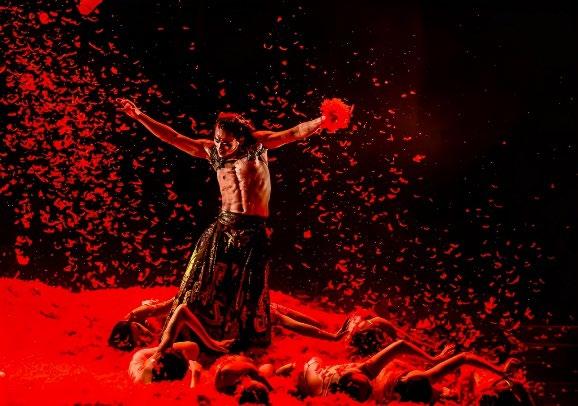
generation descendant of historical figure Confucius, and it has toured more than 300 times nationwide so far 69
Chinese modern dance drama Under Siege (十面埋 伏 , 2015) (Figure 32)produced by legendary folk dancer and choreographer YANG Liping and performed by her Alma Mater, Central Ethnic Song and Dance Troupe, was an experimental masterpiece announcing the magnificent transformation of dancer YANG Liping into a modern dance director 70 It was a bold experiment by her to interpret Chinese culture in a more abstract way, connecting ancient and contemporary China and seeking common nature of human and their emotional appeals across different times. 71

Chinese ballet drama Dunhuang (敦煌,2017) (Figure 33)starring prima ballerina CAO Shuci, was a masterpiece produced by National Ballet of China, taking inspiration from Dunhuang Classical Dance, telling a touching story of Dunhuang murals located in Northwest China. 72 This ballet drama combined Western ballet with Eastern historical stories, creating a wonderful cultural collision. 73 The performance of Dunhuang at Chinese Spring Festival Gala let not only domestic but also overseas audiences felt the vicissitudes of the thousand year old desert in Dunhuang, Northwest China. 74
Chinese revolutionary-themed contemporary dance drama The Eternal Wave (永不消逝的电波,2019) (Figure 34) starring lead dancer ZHU Jiejing, produced by Shanghai Dance Theatre, the cover photo of this dissertation,
69 China National Opera & Dance Drama Theatre, ‘Dance Drama Confucius’, China National Opera & Dance Drama Theatre, 29 September 2014 <http://www.cnoddt.com/cont.aspx?newsId=665&TId=10> [accessed 10 November 2024].
70 Wenzhou Grand Theatre, ‘12 Details to Interpret the Metaphors Behind Yang Liping's Dance Drama Under Siege’, Weixin, 15 November 2021 <https://mp.weixin.qq.com/s?__biz=MjM5MDY3NTU2MA==&mid=2650781945&idx=1&sn=cec38ba944f607f39302eaf7dc9016d0&chksm=be4a3ffe893 db6e88c1937ffbb11a1c237df554336dd59f3e65aa642ea8996fc41e399ab50b3&scene=27> [accessed 10 November 2024].
71 China Ethnic Song & Dance Ensemble, ‘Yang Liping’, China Ethnic Song & Dance Ensemble, n.d. <https://www.zymzgwt.com.cn/zymzgwt/c103498/202306/1164869.shtml> [accessed 10 November 2024].
72 National Ballet of China, ‘Dunhuang’, National Ballet of China, 26 December 2018 <https://www.nbc.cn/img_content-3443-10665.html> [accessed 10 November 2024].
73 Ibid.
74 Ibid.
Figure 32. Modern dance drama Under Siege © Yang Liping Dance Troupe
Figure 33. Ballet dance drama Dunhuang © National Ballet of China

was the beginning of the explosive popularity of Chinese dance drama across the country. 75 The Eternal Wave told a story of the underground workers of the China Communist Party made sacrifices in Shanghai for the national victory during the War of Resistance Against Japan. 76 Dancers on stage carried the indomitable spirit of their predecessors and ignite the Chinese audience's respect for the revolution This dance drama has adapted into a film issued in June 2024. 77 In recent years, many outstanding dance dramas have had the experience of being adapted into films and still popular nationwide
2.1.4 Platform period starting in 2020s
The arrival of the pandemic has reduced the frequency of people going to theatres to watch live performances. Not only was the production of Chinese dance dramas reduced and delayed, but also the survival of theatres, dance troupes or companies, and dancers was threatened. When people spent most of their time at home or other places indoors, they tended to watch TV programs or play videos on an electronic device as methods of entertainment. Live shows, especially relatively niche dance drama performances, had lost a lot of market share.
To save the economy of theatres and solve the survival problem of dance troupes, dance dramas broadcast live via electronic devices, or the ones pre-recorded began to appear in the industry. There was no audience in the auditorium at the theatres but cameras and recorders instead. Dancers or dance drama actors danced in front of empty auditoriums, as professionally and enthusiastically as if they were in front of real audiences. People bought cut-price tickets for watching online dance drama performances on their device or watch free dance drama performances for public welfare.
75 Shanghai Dance Theatre, ‘The Eternal Wave’, Shanghai Dance Theatre, 27 July 2020 <http://www.shgwt.com.cn/work-details?article_id=23> [accessed 10 November 2024].
76 Ibid.
77 Shanghai Morning Post, ‘The opening film of the Shanghai Film Festival, The Eternal Wave, has been innovatively adapted. Why do generations of audiences love the story of "radio waves"?’, Baijiahao, 17 June 2024 <https://baijiahao.baidu.com/s?id=1802095766953342187&wfr=spider&for=pc> [accessed 10 November 2024].
Figure 34. Contemporary dance drama The Eternal Wave. © Shanghai Dance Theatre

The new performance format, recorded or live, has been a challenge for both theatres and dancers. Dance drama online could be seen by a larger range of people because of strong publicity on the Internet, but the drama production itself and dancers themselves needed to bear more public opinions pressure In general, the promotion of online live or recorded dance dramas is more conductive to disseminating culture and values, exploring potential audiences' groups, and increasing the box office of live performances after the alleviation of the pandemic.
During the pandemic, Dream of the Red Mansion (红楼梦,2021) (Figure 35) produced by Jiangsu Grand Theatre and Nanjing Traditional Orchestra, is an example of the peak popularity of Chinese classical dance drama both on the Internet and on the scene. 78 As a classical dance drama adapted from the Chinese novel with the same name, Dream of the Red Mansion (2021) told a story of the prosperity and decline of four wealthy merchant families in Southeast China in the 18th century, which includes a heart-wrenching love tragedy between the male and female protagonists, JIA Baoyu and LIN Daiyu. 79 At the end of 2021, China has basically overcome the pandemic, and dance dramas, dancers and audiences are returning to theatre one after another. Team Jiangsu Grand Theatre managed to gather the principal dancers of various provinces in China to perform together for this pinnacle of Chinese literature history. 80 There have been over 200 offline performances of the dance drama Dream of the Red Mansion across the country with each one sold out 81 Besides, on Chinese TikTok, the clips of this dance drama has gone viral, being discussed by millions of online viewers Post-pandemic era has brought Chinese dance drama industry both opportunities and challenges, and theatres with dance drama producers are actively exploring their ways of survival and development
78 Tianqiao Art Centre, ‘Original dance drama Dream of the Red Mansion by Jiangsu Grand Theatre’, Tianqiao Art Centre, 21 August 2024 <http://www.zypw.org/ShowNews.asp?id=5181> [accessed 10 November 2024].
79 Communication University of China-Cloud Information, ‘Art | Jiangsu Grand Theatre Original Ethnic Dance Drama Dream of the Red Mansion’, Communication University of China-Cloud Information, 18 October 2021 <https://file.ccmapp.cn/group1/M00/21/41/rApntWFs3e-AaUwSAAA12y23cl000.html> [accessed 10 November 2024].
80 Ibid.
81 Ibid.
Figure 35. Folk dance drama Dream of the Red Mansion. © Jiangsu Grand Theatre
2.2 Political, Cultural and Technological Influences on Chinese Dance Drama in the 21st century
2.2.1 Important political directives in 2012
The contribution of Chinese people in political history has been of great significance to the development of the whole country, therefore cultural works in China often advocate positive political appeals. On the contrary, the movements in the political arena also affect the development of Chinese cultural industry.
Chairman HU 's report at the 18th National Congress of the CPC in November 2012 proposed the political policy of ‘solidly promoting the construction of a socialist cultural power’, including ‘strengthening the construction of the socialist core values system’, ‘comprehensively improve the moral quality of citizens’, ‘enrich the spiritual and cultural life of the people’ and ‘enhance the overall cultural strength and competitiveness’. 82
Chinese dance drama industry has been deeply influenced by these policies since then. Theatre designers and started to consider integrating local and regional characteristic into architectural design, boycotting blindly designing theatre architecture with low utilisation rates or impracticality for cities Dance drama producers started to deeply explore stories that reflect the current lifestyle of the people and use Chinese traditional culture as foundations and inspiration for dance drama production, promoting Chinese socialist values that align with the interests of the general public in creative ways. Dance drama started to seek a balance between the adoption of Chinese and Western cultures, allowing not only domestic audiences to have the opportunity to appreciate Chinese performing arts culture.
2.2.2 Cultural and social needs for large-scale theatres and dance drama telling Chinese stories

82 Xueyang Zhang, ‘Chairman Hu Jintao's report at the 18th National Congress of the CPC’, Communist Party Member Network, 17 November 2012 <https://www.12371.cn/2012/11/17/ARTI1353154601465336_6.shtml> [accessed 10 November 2024].
Figure 36. Epic dance drama Song of the Chinese Revolution. ©Unknown

Since Chinese dance drama formally emerged and spread widely last century, it has garnered strong public support. Large theatres cater well to China's vast population and their desire to experience and preserve traditional culture. These venues are crucial for artistic research and innovation, providing essential infrastructure for the growth of Chinese dance drama. Dance dramas that tell Chinese stories play a significant role in preserving and reviving traditional culture, history, and folklore, making them accessible and meaningful for contemporary audiences. Through storytelling, Chinese dance drama communicates unique cultural values and identity to diverse audiences, fostering greater global appreciation. By sharing these narratives, people across different backgrounds in China connect through common themes and symbols, strengthening social unity.

The author’s family has a deep feeling towards Chinese dance drama and theatre. According to the author’s father experience, he watched Song of the Chinese Revolution (中国 革命之歌,1984) 83 (Figure 36), a large-scale epic of Chinese Music and Dance drama produced in the 1980s as a work celebrating the 35th anniversary of the founding of the People's Republic of China 84 , and he was deeply moved by it. Although that dance drama lasted for three hours, he was very involved in the plot and was infected by the revolutionary enthusiasm of the Chinese people. He told me that, he felt the shock brought by dance was irreplaceable by language. Author’s mother used to be active as an amateur dancer in her hometown Yangjiang’s Grand Playhouse and Yangjiang’s Cinema & Theatre, which are now demolished. She told the author about her stories of representing her elementary and middle school as the opening dancer for a series of dance performances in front of hundreds of local audiences, which made her a theatre enthusiast for decades. In the city Dongguan where she lives now, she constantly watches performance in Yulan Grand Theatre, including contemporary
83 Ping Yu, ‘From "Long Live the Victory of the People" to "The Road to Rejuvenation of China" - Reflections on 60 Years of Dance Art in New China’, China Federation of Literary and Art Circles, 28 September 2009 <https://www.cflac.org.cn/ysb/2009-09/28/content_17839622.htm> [accessed 10 November 2024].
84 Retired Cadre Bureau, ‘Three music and dance epics from three historical periods’, Ministry of Culture and Tourism of the People's Republic of China, 2 March 2011 <https://www.mct.gov.cn/whzx/bnsj/ltxgbj/201111/t20111128_824554.html> [accessed 23 December 2024].
Figure 37. Contemporary dance drama Shanghai Beauty ©Jinxing Dance Theatre
Figure 38. Folk dance drama Peacock by Dancer YANG Liping ©Gaga Jackson
dance drama Shanghai Beauty (迷魅上海,2005) (Figure 37) choreographed by Chinese modern dance master JIN Xing 85 and folk dance drama The Peacock (孔雀,2022) (Figure 38) choreographed by dance legend YANG Liping 86 Recently, author’s parents are very excited when they heard the news that a Citizen Cultural & Art Centre and an Opera House are about to be built in their hometown Yangjiang. 87 Yangjiang is also the author's hometown, and it is very hopeful to feel the future development of performing arts out there.
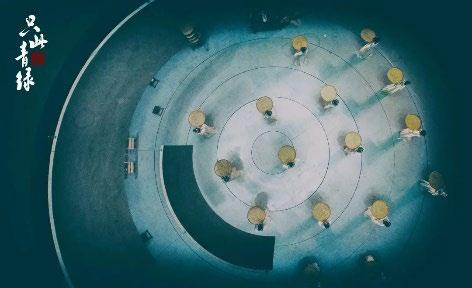
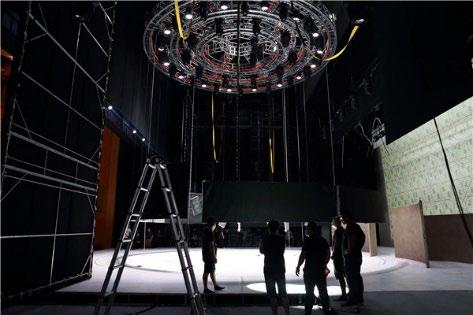
2.2.3 The Role of Stage Technology in Chinese Dance Drama
Modern Chinese theatres are professional in supporting facilities, internal layout, and stage quality. Advanced supporting facilities such as the most important audio facilities, lighting facilities, stage machinery, and stage effect facilities are basically all high-end imported products to fulfil its best performance function
Chinese poetic dance drama The Journey of a Legendary Landscape Painting (只此青绿, 2022) (Figure 39-40, Figure 41) is an excellent example of stage scenery. The drama takes the famous painting of the Song Dynasty ‘A Thousand Miles Map of Rivers and Mountains’ as the background, adopts a space-time staggered narrative structure, follows the perspective of a modern researcher in the Forbidden City, and enters the inner world of the young painter WANG Ximeng thousands of years
85 Heather, ‘The 2017 national tour of Venus Dance Troupe has begun!’, Weixin, 6 March 2017 <https://mp.weixin.qq.com/s?__biz=MzA5NTkzOTYwOA==&mid=2651605150&idx=4&sn=75acdbc1a00c39eff73ee9d8eb220088&chksm=8b4f55e9bc3 8dcff0bacdf98a0bbc25ce6d0ff13449dcb3caffd3fb82b89f3f1c6e8ccd91155&scene=27> [accessed 10 November 2024].
86 ‘Yang Liping: Peacock is my lifelong spiritual pursuit’, Sohu, 8 July 2023 <https://www.sohu.com/a/695687473_115354> [accessed 10 November 2024].
87 Yangjiang Daily, ‘What will Yangjiang Opera House look like? Architects, dancers, and singers all have their own words to say’, Weixin, 5 November 2020 <https://mp.weixin.qq.com/s?__biz=MjM5NTY3MjgyNA==&mid=2651044013&idx=1&sn=dcb52cbe95715de675841f4a1630f83b&chksm=bd03ff3a8a74 762c2ba679e22798e80b016ce9d9840f72cecac8f4c674e9d2ea5dfa9ac1a2aa&scene=27> [accessed 10 November 2024].
31
Figure 39-40. Stage settings of Poetic dance drama The Journey of a Legendary Landscape Painting © Oriental Song and Dance Troupe

ago. 88 For stage scenery, it uses a concentric circle stage layout, with ground turntables and aerial circular arc mechanical movements, creating a stage design effect of ‘celestial rotation reaches 3 circles, ground rotation reaches 4 circles, and can move up, down, left, and right’ 89 The concentric circle layout of the dance drama restores the process of traditional Chinese painting scroll exhibition 90 The use of the concentric circle installation of three circles of celestial rotation and four circles of earthly rotation represents a symbol of the cultural ecology of the Song Dynasty. Props such as a round moon, bamboo baskets in the hands of silk weavers, and graphite circles in the hands of ink makers accompany the concentric circle installation on stage 91 As the image sequence combination of circle, it is rooted in the spirit of the unity of sky and human in Chinese culture. 92
Stage scenery itself performs. It reshapes the empty theatre space, taking the audience into a new space derived from the dance drama, serving a short period of two or three hours. It is a special space that still lives in the audience's consciousness after the dance drama ends.
88 Ning Xiang, The crystallization of art, the sublimation of spirit - Appreciation of 100 excellent dance works in New China (Jiangsu Renmin Press, 2024), pp.463-464.
89 Ning Xiang, The crystallization of art, the sublimation of spirit - Appreciation of 100 excellent dance works in New China (Jiangsu Renmin Press, 2024), pp.463-464.
90 Ibid.
91 China Central Television, ‘"The Journey of a Legendary Landscape Painting" "Dance" on the big screen to restore the ultimate Chinese aesthetics’, China Central Television, 22 September 2024 <https://content-static.cctvnews.cctv.com/snow-book/index.html?item_id=6245831479133385265> [accessed 10 November 2024].
92 Ibid.
Figure 41. Photo of Poetic dance drama The Journey of a Legendary Landscape Painting © Oriental Song and Dance Troupe
Chapter 3 Interplay between Chinese Theatre Architecture and Dance
Drama
3.1 Emergence of Notable Productions, Choreographers and Dance Troupes, and the Challenges They Face
3.1.1 Prospect and predicament of Chinese dance drama production
Dr. JIANG Dong, Deputy Director of the Dance Research Institute of the Chinese Academy of Art, said in his book Hua Wu Ju Ying (华舞咀英,Tasting the flowers of Chinese dance industry) that, in terms of quantity, China is a major country in dance drama, which we may not be proud of it, but building confidence in the future development of Chinese dance drama through quantity is sincere 93 Since the 21st century, Chinese dance dramas have flourished in terms of quantity, with indeed works that can withstand the test of time, as well as many works that have been obscured by the tide of history. Encouraged by national policies, more and more choreographers and directors are inheriting and innovating Chinese culture in their dance drama works, and some of them even have the ability to take their works and theatre troupes to the world. Chinese dance drama production has received a lot of support and has a bright future ahead
It is difficult to unify the criteria for determining whether a dance drama is good or bad, however, there is a big difference between doing art and doing entertainment. Choreographers for Chinese dance drama industry nowadays have different levels of understanding of art, for example, YANG Liping is an established real artist in Chinese dance drama industry. She devoted all her enthusiasm to dancing and she has been active as a dancer and choreographer for 40 years, creating countless dance works that people all over the country enjoy talking about. 94 Under the prosperous foam, Chinese dance drama has hidden many problems, such as the extravagant scenery, costumes and props, which is called ‘form’ over ‘substance’; vague concepts for dance drama, especially for some modern dance works, which made audience feel confused; shallow application of Chinese and Western cultures, lack of profound understanding of culture leads to the inability to create works with depth, etc. Creating arts takes time and if works are completely commercialised due to a focus on the market, it is impossible to create real art that manifest the spiritual core we are proud of.
3.1.2 Survival and growth of Chinese dance drama troupes and dancers
As downstream of Chinese dance drama industry, dance drama troupes and dancers are in a relatively passive position Unless they are master-level dancers who work for themselves, having a national-level professional
93 Dong Jiang, Jiangdong Dance Collection: Huawu Zuiying · Comment Volume (Shanghai Music Press, 2014), p. 145
94 Shasha Liu, ‘After bidding farewell to the stage, Yang Liping - the stage of the soul is everywhere’, China Writer Web, 25 October 2017 <https://www.chinawriter.com.cn/n1/2017/1025/c404005-29607822.html> [accessed 10 November 2024].

title, establishing their own dance troupes and enjoying special financial support to maintain the progress of dance drama research projects and their own creations, dancers need to either join national, provincial, municipal or individual dance troupes, or join educational or research institutions in order to have income and a fixed and stable workplace to accumulate work results In today's relatively flat economic development in China, due to dance drama market shrinkage, fiscal subsidies have become a source of income for many national, provincial, and municipal dance troupes. Theatre has been the main venue for the growth of both dance drama troupes and dancers since it is a professional space for performing arts. Against the backdrop of economic downturn globally, some small theatres in China had lain idle or had been abandoned, and some municipal dance drama troupes in China are disbanding before their names are remembered by people Some dancers have lost their jobs or switched careers The time is unmercifully shaping the future of theatres, dance drama troupes and the dancers.

The survival of individual theatres and dance troupes is the most difficult Taking Xiexin Dance Theatre as example (Figure 42) , it is a relatively small-scaled theatre and dance troupe in Shanghai founded by modern dance master XIE Xin, who used to work for Guangdong Modern Dance Company, a provincial modern dance unit, and three other famous individual dance troupes, Jinxing Dance Theatre, Tao Dance Theatre and Beijing Dance LDTX. 95 Due to the fact that the
95 Shanghai Theatre Academy, ‘Xie Xin - Dance Workshop’, Shanghai Theatre Academy, 21 October 2015 <https://wd.sta.edu.cn/05/b3/c394a1459/page.htm> [accessed 10 November 2024].
Figure 42. Xiexin Dance Theatre before the fire. © Xiexin Dance Theatre
Figure 43 Dancer XIE Xin dancing in burnt ‘white room’ with her dance troupe in m memory of the fire.
© Xiexin Dance Theatre
dance troupe is responsible for its own profits and losses, the venue is located in a less affluent old city area 96

After a huge fire happened to Xiexin Dance Theatre caused by fires in surrounding factories, the rehearsal hall of this dance troupe, once known as the nickname ‘White Room’, was burned down to ashes 97 (Figure 43) Upon hearing the news of the fire, Shanghai International Dance Centre and Shanghai Dance Theatre kindly offered rehearsal studios for XIE Xin and her troupe members to rehearse their new dance piece. 98 As a dancer, choreographer, independent dance troupe operator, and a mother, Xie Xin is a very powerful woman Her dance troupe did not come to a halt due to this big fire. On the contrary, she still enthusiastically carries her works on a global tour and rebuilds her beloved self-funded new theatre on the original site, which is expected to be completed by March 2025(Figure 44) 99 Xiexin Dance Theatre is like a phoenix that rebirths from ashes.
96 Tong Wu, ‘Can Xie Xin Dance Theatre be reborn after a big fire burns down the 'White Room'?’, Shanghai Observer, 19 January 2024 <https://export.shobserver.com/baijiahao/html/705623.html> [accessed 10 November 2024].
97 Tong Wu, ‘Can Xie Xin Dance Theatre be reborn after a big fire burns down the 'White Room'?’, Shanghai Observer, 19 January 2024 <https://export.shobserver.com/baijiahao/html/705623.html> [accessed 10 November 2024].
98 Ibid.
99 Xiexin Dance Theatre, ‘The shattering of 'mottled' is another form of growth for Xie Xin’, Weibo, 7 November 2024 <https://weibo.com/ttarticle/p/show?id=2309405098135222354051> [accessed 10 November 2024].
Figure 44. Xiexin Dance Theatre's rebuilt in progress © Xiexin Dance Theatre
3.2 Global Influence of Chinese Dance Drama Production
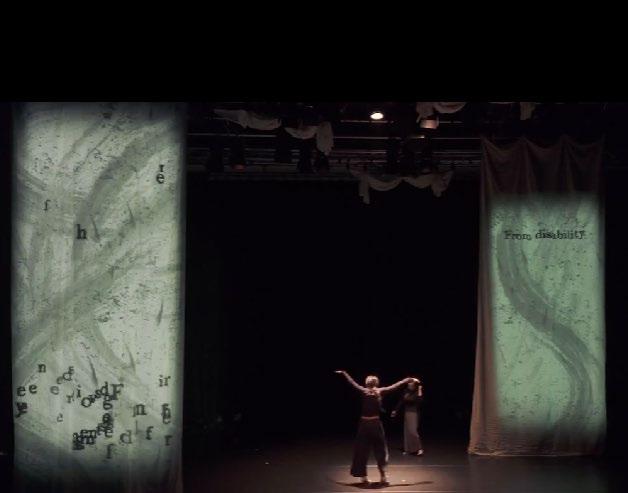


For recent Chinese dance drama production, English has started to appear in Chinese dance drama for global audience. In a contemporary poetic dance drama called Ten Thousand Tons of Moonlight, 100 that the author had watched in April 2024 at Dance City Newcastle, the stage set has an English subtitle projection corresponding to the Chinese subtitles (Figure 45) The actress who spoke English lines and two female dancers who spoke Chinese lines perform simultaneously on stage The audiences received English translation of the performance content digitally in advance before the performance began.
The one-hour performance was a perfect collaboration among two Chinese dancers called Jilan Dong 101 and Kehua Li, modern Chinese poet YU Xiuhua as the main character, and a British actress called Tianlan(Figure 46) . It told the story of the staggering life of poet YU, who suffers from cerebral palsy, and the moonlight in her eyes. Except for a few Chinese who came from afar, most of the audience were local British people who were unfamiliar with Chinese, but English
<https://www.fenglingproductions.com/tenthousandtonsofmoonlight>
<https://www.fenglingproductions.com/mayajiliandong>
100 Fengling Productions, ‘Ten Thousand Tons of Moonlight’, Fengling Productions, 2023
[accessed 10 November 2024].
101 Fengling Productions, ‘Maya Jilan Dong, Choreographer/Dancer’, Fengling Productions, 2023
[accessed 10 November 2024].
Figure 45 English subtitles of Poetic dance drama Ten Thousand Tons of Moonlight © Fengling Productions
Figure 46 Four performers of Poetic dance drama Ten Thousand Tons of Moonlight © Fengling Productions
Figure 47. The author (first row, second from the left) joined postshow talk of Ten Thousand Tons of Moonlight
© Fengling Productions
projection and English reading allowed them to enter the story and get a similar feeling to the Chinese audience
After watching the dance drama and joining the post-show talk(Figure 47), the author precepted that, language is a major obstacle on the path of internationalisation for Chinese dance dramas. Many Chinese dance dramas are very popular in China; however, it is a pity that audience from outside of China have never heard of them and are unable to understand the performance content in depth due to language and cultural barriers But as humans, even from different countries, the rhythm of the human body in time and space is a language that can be felt by all of them, and they have the ability to be moved by performances

In recent years, some excellent Chinese dance troupes, specialising in Chinese modern dance, like Xiexin Dance Theatre and Tao Dance Theatre, have brought their original Chinese dance drama works to theatres around the world 102 The author found that compared to the difficulty to translate stories of Chinese
classical dance drama, Chinese ethnic and folk dance drama, whereas Chinese contemporary and modern dance drama, as well as Chinese ballet drama are more likely to enter the international market at present Although there are exceptions, such as Chinese contemporary dance drama Wing Chun (咏春,2022) (Figure 48) originally produced by Shenzhen Grand Theatre, which has been embarking on its first overseas tour since September 2024, having London as its first stop, and it is highly praised by local dance and theatre practitioners recently 103
3.3 Case Study of Successful ‘Theatre + Dance Troupe’ Cooperation in China
The author chose three top cities in China Mainland Beijing representing northern China, Shanghai representing eastern China and Guangzhou representing southern China to discuss four case studies which cover four types of different Chinese dance drama performance famous in different regions in China.
102 Tao Dance Theatre, ‘About the Company’, Tao Dance Theatre, 2016 <http://taodancetheater.com/Archives/IndexArctype/index/t_id/9.html> [accessed 10 November 2024].
103 Shenzhen News, ‘Debuting in London, UK, the dance drama 'Wing Chun' travels from Pingshan, Shenzhen to the world’, Baijiahao, 7 September 2024 <https://baijiahao.baidu.com/s?id=1809548731512729418&wfr=spider&for=pc> [accessed 10 November 2024].
Figure 48. A scene of dance drama Wing Chun © Shenzhen Daily
3.3.1 National Centre for the Performing Arts (2007), Beijing + China National Opera and Dance Drama Theatre
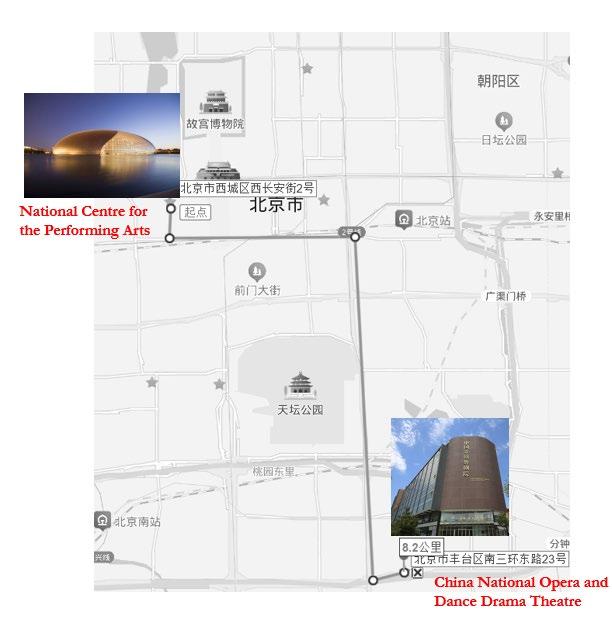
Figure 49 8.2km distance between National Centre for the Performing Arts and China National Opera and Dance Drama Theatre in Beijing. © Baidu Map
Accommodating the most authoritative ensemble for Chinese Dance Drama, China National Opera and Dance Drama Theatre has compiled a large number of domestic dance dramas with epochmaking significance and has exported many famous dancer and choreographers to the Chinese dance drama industry since its establishment in 1964 104 Less than 10km away to its northwest, there is National Centre for the Performing Arts, the well-known ‘art palace’ with highest artistic status in the nation There is a close cooperative relationship between the Centre and this Dance Drama Ensemble, which is reflected in various aspects. 105 By jointly organising Chinese dance drama performances, the Centre provides world-class performing art facilities and international platforms for artistic communication between the performers and the audience, whereas the Dance Drama Ensemble enriches dance drama contents and enhances dance drama’s influences on the region and wider area. 106
3.3.2 Tianqiao Theatre (rebuilt in 2001)+ National Ballet of China
National Ballet of China as the best Chinese ballet company famous for telling revolutionary stories and traditional legends across the country by producing original Chinese ballet drama since 1953, which is also located in Beijing, is the first place to lay the foundation for training Chinese ballet talents since the last century 107 Less than a 1km distance, Tianqiao Theatre, the time-honoured first ever contemporary theatre in China which was built in last century and rebuilt twenty-four years ago, is affiliated to National Ballet of
104 China National Opera and Dance Drama Theatre, ‘Theatre Introduction’, China National Opera and Dance Drama Theatre, n.d. <http://www.cnoddt.com/info.aspx?clmId=31> [accessed 23 December 2024].
105 China National Centre for the Performing Arts, ‘The NCPA’, China National Centre for the Performing Arts, 2024 <https://en.chncpa.org/aboutus/> [accessed 26 September 2024].
106 National Centre for the Performing Arts, ‘Box Office’, National Centre for the Performing Arts, 2024 <https://www.chncpa.org/searchall/?sw=> [accessed 23 December 2024].
107 National Ballet of China, ‘Dance Drama’, National Ballet of China, 2020 <https://www.nbc.cn/about_repertoire_all-3401.html> [accessed 10 November 2024].
China, who has benefited from this exclusive contract, allowing professional and trainee dancers to perform at a fixed venue for a long time. 108 Stable sources of ballet dance drama production and performance has made Tianqiao Theatre avoid having space waste and operational shortfall as some of the theatres in China experiencing, as well as has promoted the cultural trend of local performing arts cultural inheritance and exchange

3.3.3 Shanghai International Dance Centre (2016) + Shanghai Dance Theatre Co Ltd.
Located in Huangpu District at the heart of Shanghai City, Shanghai Dance Theatre Co Ltd., a provincial dance ensemble established in 1979 and nationally famous for plenty of its contemporary dance drama like The Eternal Wave, has been good at combining traditional culture with modern stage art and creating works with both a sense of the times and national characteristics 109 Shanghai International Dance Centre, which is less than 100 meters away, is the place where this prestigious dance company shines. Shanghai International Dance Centre provides high-quality performance and rehearsal venues for Shanghai Dance Theatre Co Ltd. and has become one of its important art exhibition platforms. 110 At the same time, Shanghai Dance Theatre Co Ltd., as one of the important resident art groups of Shanghai International Dance Centre, often holds
108 Tianqiao Theatre, ‘Theatre Overview’, Tianqiao Theatre, n.d. <https://www.tianqiaojuyuan.com/overview.html> [accessed 25 October 2024].
109 Shanghai Dance Theatre, ‘The Eternal Wave’, Shanghai Dance Theatre, 27 July 2020 <http://www.shgwt.com.cn/work-details?article_id=23> [accessed 10 November 2024].
110 Shanghai International Dance Centre, ‘SIDCT Youth Incubation Platform’, Shanghai International Dance Center, 2024 <http://www.shdancecenter.com/detail?id=18> [accessed 27 September 2024]
Figure 50. One-kilometre distance between National Ballet of China and Tianqiao Theatre in Beijing. © Baidu Map
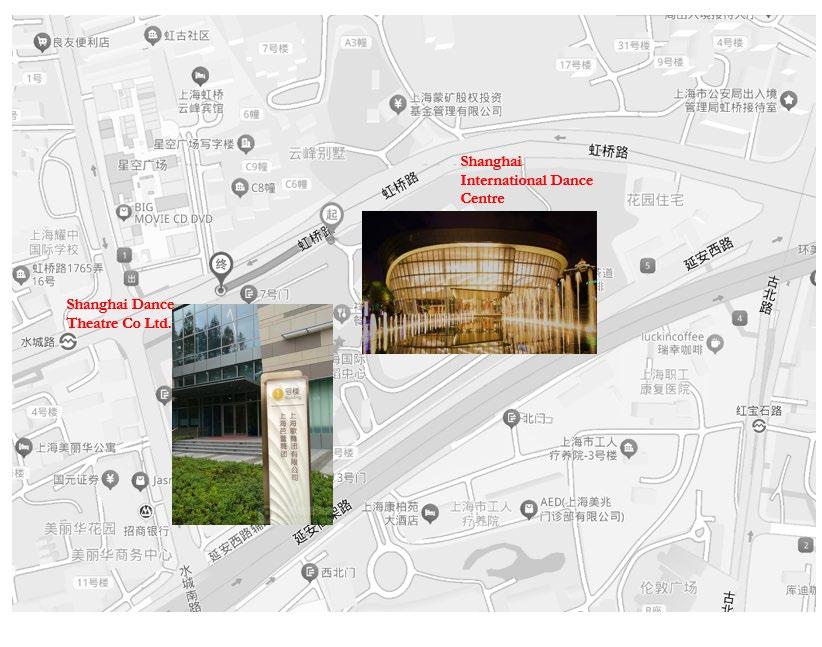
3.3.4 Guangdong Arts Theatre (2014) + Guangdong Modern Dance Company
Located in southern China, Guangdong Modern Dance Company, as one of the leading modern dance troupes in China, has been producing numerous successful Chinese modern dance pieces since established in 1992. 112 It consistently emphasizes the innovation and progression of modern dance, seeking to integrate various cultural influences and artistic mediums, resulting in experimental and highly artistic dance dramas. 113 The Company not only thoroughly investigates traditional Chinese culture and local characteristics but also actively incorporates concepts and techniques from Western modern dance, merging Chinese elements with contemporary global dance trends. 114 As a sub group of Guangdong Art Theatre, Guangdong Modern Dance Company has the resources and support of the theatre, including funds, venues and performance platforms. 115 Guangdong Art Theatre provides administrative and organizational support for the
111 Shanghai International Dance Centre, ‘Commissioned by SIDCT’, Shanghai International Dance Centre, 2024 <http://www.shdancecenter.com/sidct> [accessed 23 December 2024].
112 Guangdong Provincial Department of Culture and Tourism, ‘Guangdong Modern Dance Company’, People's Government of Guangdong Province, 10 July 2019 <https://www.gd.gov.cn/gdywdt/zwzt/whlyhdzn/gddt/content/post_2535285.html> [accessed 23 December 2024].
113 Guangdong Modern Dance Company, ‘Guangdong Modern Dance Company Black Box Theatre’, Guangdong Modern Dance Company, 2024 <http://gdmdc.com/zh-cn/thetheatre/> [accessed 27 September 2024].
114 Guangdong Modern Dance Company, ‘Performance Footprint’, Guangdong Modern Dance Company, 2024 <http://www.gdfestival.cn/zh-cn/about-the-company/archives/> [accessed 24 December 2024].
115 Guangzhou Metro, ‘What are the secrets behind and in front of Guangdong Art Theatre?’, WeChat Official Account, 3 September 2024 <https://mp.weixin.qq.com/s?__biz=MzA4MDAwMjAwNA==&mid=2653644497&idx=1&sn=9d56d65b05582be950625b70ad6c173d&chksm=8548d533 2b63297628bce3314e72c9de48676cdbb2f7a51240baafd020f3ae77dd4ccd1d7fd9&scene=27> [accessed 23 December 2024].
40 dance premieres, special performances and exchange activities there. 111
Figure 51. 100m distance between Shanghai Dance Theatre Ltd. and Shanghai International Dance Centre. © Baidu Map
performance and creation of the dance troupe, helping the dance troupe gain greater development space in the field of dance at home and abroad 116

In summary, the four case studies has demonstrated that the collaboration between theatre and dance troupe , which are geographically close to each other, can lead to shared resources, innovative artistic development, and increased influence. The dance troupe can leverage the theatre’s advanced facilities and performance venues to enhance the quality and impact of their dance drama performances, while also bringing diverse artistic content that appeals to a larger audience. Through enduring and stable partnerships, dance troupe gains more opportunities to perform, and the theatre increases its artistic reputation and cultural significance. This collaboration not only fosters interaction between the audience and artists but also supports the training and growth of stage art talents, ultimately achieving mutual benefits and success for both parties.
116 Nanfang Daily, ‘Grand Theatre of Guangdong Performing Arts Centre was renamed Guangdong Art Theatre’, People's Government of Guangdong Province, 17 January 2019 <https://www.gd.gov.cn/zjgd/lnwh/whzx/content/post_1408024.html> [accessed 23 December 2024].
Figure 52. 390m distance between Guangdong Modern Dance Company and Guangdong Arts Theatre. © Baidu Map
Conclusion
Key
Findings and Insights
Modern Chinese theatres and Chinese dance drama in the 21st century is a typical example of mutually reinforcing relationship between architectural aesthetics and performing arts in China’s cultural industry. Chinese theatres nowadays, both large-scale government-funded theatres and individually built ones, serve as carriers for the dissemination of local and regional Chinese culture in dance drama sector, contributing to a more prosperous modern China in terms of economy, politics and culture by its architectural functions. Moreover, as a base for the creation, promotion and performance of Chinese dance drama industry, modern Chinese theatres have brought hope for domestic dance dramas to have a place in the global dance world in the near future. Chinese dance drama in this century benefits from the establishment of Chinese dance through various ancient Chinese dynasties and the formal systematisation that began in the last century, making itself actively strive for a balance between domestic dance drama contents and the ones affected by internationalisation, as well as traditional and modern performance methods and forms. Around seventy years of struggling, Chinese dance drama industry gradually took shape since the 1950s and made invaluable preparations for the rapid development of dance drama in 21st century
Suggestions and Prospects for Chinese Theatre Architecture and Dance Drama
After careful research of both Chinese theatre architecture and Chinese dance drama, the author has been gratified with the flourishing development of the Chinese dance drama industry these days, while the future of this industry in architecture and performing arts aspects has also set the author deep thoughts. Both continuous efforts of Chinese people as well as work of significant governmental investments and instructions have paid off, creating a promising theatre and dance drama industry in China However, to solve the problem of a number of modern Chinese theatres reducing box office revenue or even on the brink of closing down due to the impact of advanced network technology which has nourished popular digital contents, there is a need of linkage between different fields in dance drama industry
A steadily-funded financial support plan for dance drama choreographers and directors to encourage original dance drama production, as well as accesses to high-quality domestic and international professional courses of dance drama and the establishment of talents echelon system to cultivate new practitioners The local government should improve the maintenance and repair work of both exterior and interior of theatre architecture, providing solid support for dance drama performances To build a new theatre in a city, it is necessary to consider the local economy and geographical conditions, and most importantly, the local cultural characteristics in order to construct a theatre that is loved by people and convenient for people. Theatres, dance troupes, and local dance institutes should maintain close cooperation to ensure the continuity of the
industry's supply chain system, making the production, promotion, and performance of dance dramas profitable in the sense of economic and cultural popularisation. Activities such as dance drama festivals, dance drama weeks, and dance drama classes for public welfare can increase citizens' cultural participation and willingness to inherit Chinese traditional performing arts culture, providing long-term enthusiastic audiences for Chinese dance dramas
In the future, the architecture of Chinese theatres and the art of Chinese dance drama will innovate and integrate together. Theatre design will focus more on modernity, intelligence, and multifunctionality, seamlessly blending traditional Chinese cultural elements to become a significant space for artistic creation and audience engagement. Concurrently, Chinese dance dramas will offer an immersive viewing experience by deeply fusing technology with art while maintaining national identity, effectively narrating Chinese stories through global exchanges. The collaborative growth of both fields will aid in promoting the international presence of Chinese performing arts and boosting cultural soft power.
List of Figures
Cover Photo: Chinese contemporary dance drama The Eternal Wave by Shanghai Dance Theatre.
Chinese Cultural Daily, Dance drama 'The Eternal Waves': The seamless integration of modern technology and stage art, 8 February 2021, photograph <https://www.workercn.cn/c/2021-0208/6637216.shtml> [accessed 4 November 2024]
Figure 1. The author in Xinjiang Dance costumes when she was four.
Photographed by author’s mother Huali Chen.
Figure 2. The author performing for Newcastle University Dance Club annual show Disco Inferno 2024 at Northern Stage Newcastle.
Zhane, Kieran, NCL_Dance_Club_Summer_2024_Show_2-74.jpg, 11 May 2024, photograph <https://www.kzcapturedmoments.gallery/ncldanceclub/?pid=12734660867&id=66&h=MzU2NDE0NTExOA> [accessed 4 November 2024]
Figure 3. Map of China with theatres mentioned in this dissertation.
Author s own image traced from: gov.cn, ‘Map of the People's Republic of China’, gov.cn, 2019 <https://www.gov.cn/guoqing/2017-07/28/content_5043915.htm> [accessed 23 December 2024]
Figure 4. Yulan Grand Theatre.
Hymchu, Dongguan Yulan Grand Theatre and its surroundings, 18 January 2021, photograph <https://www.thepaper.cn/newsDetail_forward_10841410> [accessed 4 November 2024]
Figure 5 Zhuhai Grand Theatre.
Photographed by author’s friend Hetian Gu.
Figure 6 Fuzhou Strait Cultural Art Centre.
Goodwin, Marc, Virgile Simon Bertrand and Pano, What a beautiful 'jasmine flower', Fuzhou Strait Cultural and Art Center, 10 July 2024, photograph <https://zhuanlan.zhihu.com/p/708115202> [accessed 4 November 2024]
Figure 7. Harbin Grand Theatre.
Wang, Wei, Harbin Grand Theatre, 14 December 2020, photograph <https://699pic.com/tupian-501700787.html> [accessed 5 November 2024]
Figure 8. Xinjiang Grand Theatre.
Eiffel, First stop of the itinerary: Xinjiang Grand Theatre - ‘Returning to the Western Regions’, 9 May 2019, photograph <https://www.meipian.cn/23llc6yp> [accessed 5 November 2024]
Figure 9. Yangliping Grand Theatre.
Yang, Jiyuan, The Yang Liping Performing Arts Center with lights on, 16 September 2020, photograph <https://www.163.com/dy/article/FMGUJV7T0525V1M9.html> [accessed 5 November 2024]
Figure 10. Hangzhou Grand Theatre.
Commander of the Eastern Wu Navy, ‘A grand theatre like the Milky Way’, Douyin, 25 October 2022 <https://www.douyin.com/note/7158452086886141216> [accessed 6 November 2024]
Figure 11. Shanghai Poly Grand Theatre.
Lu, Richard, Shanghai Poly Grand Theatre Night aerial photography, n.d., photograph <https://www.vcg.com/creative/1163168568> [accessed 6 November 2024]
Figure 12. Nantong Grand Theatre.
Shizhi Culture, Nantong Grand Theatre, 2 December 2021, photograph <https://mbd.baidu.com/newspage/data/dtlandingsuper?nid=dt_4206539778602594922> [accessed 6 November 2024]
Figure 13 National Centre for the Performing Arts.
Yanmama, National Centre for the Performing Arts, 29 June 2024, photograph <https://baike.baidu.com/pic/中国国家大剧院 /1063477/0/d50735fae6cd7b89c3b28f74082442a7d8330e6e?fr=lemma&fromModule=lemma_contentimage#aid=0&pic=d50735fae6cd7b89c3b28f74082442a7d8330e6e> [accessed 25 October 2024]
Figure 14. Opera House, National Centre for the Performing Arts.
Chinese Oriental Culture Research Association Science and Education Specialized Committee, National Centre for the Performing Arts designer Paul Andro has passed away at the age of 80, n.d., photograph <http://www.eescc.cn/html/2018/yssl_0811/110.html> [accessed 25 October 2024]
Figure 15. Tianqiao Theatre.
Xicheng District People's Government of Beijing Municipality, Tianqiao Theatre, 9 May 2024, photograph <https://www.bjxch.gov.cn/zt/jytq/xxxq/pnidpv952342.html> [accessed 25 October 2024]
Figure 16. Auditorium of Tianqiao Theatre.
Wenyizhisheng, Tianqiao Theatre, a place for the inheritance of ballet art, 10 September 2019, photograph <https://m.sohu.com/a/340131780_183373/?pvid=000115_3w_a> [accessed 25 October 2024]
Figure 17. Shanghai International Dance Centre.
Shanghai International Dance Centre, Grand Theatre, 2024, photograph <http://www.shdancecenter.com/detail?id=12> [accessed 25 October 2024]
Figure 18 Grand Theatre of Shanghai International Dance Centre.
Shanghai International Dance Centre Development Foundation, ‘Dance Space | Shanghai International Dance Centre 2nd Anniversary Carnival, Embarking on an Exploration Journey of Dance Aesthetics’, Sohu, 13 September 2018 <https://www.sohu.com/a/253738952_765259> [accessed 25 October 2024]
Figure 19. Guangzhou Opera House.
Guo, Feiqiu, Small Night Scene of Guangzhou Grand Theatre, 2018, photograph <https://www.zcool.com.cn/work/ZMjc1OTEyNzY=.html> [accessed 27 September 2024]
Figure 20. Interior of Guangzhou Opera House.
Guangzhou Opera House, Opera House, 2011, photograph <https://www.gzdjy.org/intro.html?rid=14423&name=歌剧厅> [accessed 4 November 2024]
Figure 21. Chinese classical dance.
Fenghua Qiulu, ‘Classical Dance 'Green Belt as Wind' Tang Shiyi’, Duitang, 22 October 2014 <https://www.duitang.com/blog/?id=228795221> [accessed 10 November 2024]
Figure 22 One of the Chinese ethnic dances-Uyghur dance by Dancer Guli Mina
He, Ming, She is a born dancer, 13 March 2024, photograph <https://www.sohu.com/a/763920707_121124696> [accessed 10 November 2024]
Figure 23. Chinese modern dance by Dancer XIE Xin
Liao, Yang, What is Shen Wei's 'Rong' an 'artistic wonder' after five months of seclusion in Hainan, 17 May 2021, photograph <https://m.thepaper.cn/newsDetail_forward_12710026> [accessed 10 November 2024]
Figure 24 Han Dynasty music and dance figurines
Gaozhan Qijianyou, ‘2017 Strategy (Special Edition of the National Museum of China)’, Meipian, 28 March 2020 <https://www.meipian.cn/2u2fnmah> [accessed 10 November 2024]
Figure 25. Tang Dynasty Liyuan.
The shining moment of the disciples of the Pear Garden: Tang Xuanzong personally stepped down to guide, representing the pinnacle of Tang Dynasty music, 29 January 2023, image <https://www.sohu.com/a/635149627_120237207> [accessed 10 November 2024]
Figure 26 History of Chinese dance.
Author’s own image.
Figure 27 Folk dance drama Lotus Lantern
China National Opera& Dance Drama Theatre, ‘Lotus Lantern’, China National Opera& Dance Drama Theatre, 3 May 2002 <http://www.cnoddt.com/cont.aspx?newsId=793> [accessed 10 November 2024]
Figure 28 Folk dance drama Silk Road Flower Rain
Liu, Changzhong, ‘Live performance of 'Silk Road Flower Rain' in 1981’, Baijiahao, 20 August 2019
<https://baijiahao.baidu.com/s?id=1642384072279601487&wfr=spider&for=pc> [accessed 10 November 2024]
Figure 29. Ballet dance drama Raise the Red Lantern
National Ballet of China, ‘Dance drama from 18 years ago’, Sohu, 29 November 2019 <https://www.sohu.com/a/357256398_649578> [accessed 10 November 2024]
Figure 30. Folk dance drama Dynamic Yunnan
Yang Liping Dance Troupe, ‘Kunming Rongchuang Cultural Tourism City grandly opens! Gathering six major ethnic cultures to create a unique experience for the town’, Chinese Real Estate, 23 December 2019 <http://shenyang.creb.com.cn/wlky/99903.jhtml> [accessed 10 November 2024]
Figure 31. Classical dance drama Confucius
China National Opera & Dance Drama Theatre, ‘The Chinese Opera and Dance Drama Theatre’s dance drama ‘Confucius has been released, let's ‘dance together with Confucius!’, Sohu, 8 July 2019 <https://www.sohu.com/a/325625580_696118> [accessed 10 November 2024]
Figure 32. Modern dance drama Under Siege
Yang Liping Dance Troupe, ‘Yang Liping's Dance Theatre ‘Under Siege’ Beijing Station Music Pool Additional Seat’, NetEase, 4 June 2021 <https://www.163.com/dy/article/GBLMGJ4T0518UTO0.html> [accessed 10 November 2024]
Figure 33. Ballet dance drama Dunhuang
National Ballet of China, ‘Dunhuang Flying Apsaras on Spring Festival Gala | Dunhuang Celebrates the New Year with You’, NetEase, 5 February 2019 <https://www.163.com/dy/article/E76NL7IT0518EFCO.html> [accessed 10 November 2024]
Figure 34. Contemporary dance drama The Eternal Wave.
Shanghai Dance Theatre, ‘Why have these main melody dramas become popular’, Sina Finance, 24 January 2022 <https://finance.sina.com.cn/jjxw/2022-01-24/docikyamrmz7103115.shtml> [accessed 10 November 2024]
Figure 35 Folk dance drama Dream of the Red Mansion
Jiangsu Grand Theatre, ‘How many details are hidden in the Chinese aesthetic ceiling of 'Dream of the Red Mansion'?’, Sohu, 20 March 2024 <https://www.sohu.com/a/765584407_649115> [accessed 17 November 2024]
Figure 36 Epic dance drama Song of the Chinese Revolution.
‘Song of the Chinese Revolution’, Baidu Baike, 2 May 2024 <https://baike.baidu.com/item/中国革命之歌/4184071> [accessed 10 November 2024]
Figure 37.Contemporary dance drama Shanghai Beauty
Jinxing Dance Theatre, ‘Shanghai Beauty’, Baidu Baike, 5 July 2023 <https://baike.baidu.com/item/谜魅上海/62896383> [accessed 11 November 2024]
Figure 38. Folk dance drama Peacock by Dancer Yang Liping.
Jackson, Gaga, ‘Dance Drama Peacock 2022 version’, Weibo, 22 July 2023 <https://weibo.com/1790485872/Nb2Xw3R3D?refer_flag=1001030103_> [accessed 23 December 2024]
Figure 39-40. Stage settings of Poetic dance drama The Journey of a Legendary Landscape Painting
Oriental Song and Dance Troupe, ‘How difficult is it to showcase the 'Thousand Miles of Rivers and Mountains' on stage? The Journey of a Legendary Landscape Painting is waiting to be seen tonight’, Tencent, 24 September 2021 <https://news.qq.com/rain/a/20210924A031LG00> [accessed 10 November 2024]
Figure 41. Photos of Poetic dance drama The Journey of a Legendary Landscape Painting
Oriental Song and Dance Troupe, ‘2022 The Journey of a Legendary Landscape Painting Yangzhou Station Time, Place and Ticket Price’, Dahe Ticket Web, 16 February 2022 <https://www.dahepiao.com/news1/yanchu/20220216255751.html> [accessed 10 November 2024]
Figure 42 Xiexin Dance Theatre before the fire.
Xiexin Dance Theatre, ‘Can Xie Xin Dance Theatre be reborn after a big fire burns down the 'White Room'?’, Weibo, 19 January 2024
<https://weibo.com/ttarticle/p/show?id=2309404991853836501520> [accessed 23 December 2024]
Figure 43 Dancer XIE Xin dancing in burnt white room with her dance troupe.
Yinghua Xiyu Huawenzi, ‘Dancing in the ruins, bidding farewell to the 'little white room'’, Sohu, 27 January 2024 <https://www.sohu.com/a/754619715_121124707> [accessed 10 November 2024]
Figure 44. Xiexin Dance Theatre’s rebuilt in progress
Xiexin Dance Theatre, ‘The shattering of 'mottled' is another form of growth for Xie Xin’, Weibo, 7 November 2024
<https://weibo.com/ttarticle/p/show?id=2309405098135222354051> [accessed 23 December 2024]
Figure 45. English subtitles of Poetic dance drama Ten Thousand Tons of Moonlight
Fengling Productions (@fenglingproductions), ‘Within Her Struggle Lives a Universe of Emotions and Poetry”: Release of the Trailer for the Second Phase of Production [...]’, Instagram, 11 June 2024 <https://www.instagram.com/p/C8FYtLrt9I6/> [accessed 10 November 2024]
Figure 46. Four performers of Poetic dance drama Ten Thousand Tons of Moonlight © Fengling Productions
Fengling Productions, ‘Ten Thousand Tons of Moonlight’, Fengling Productions, 2023 <https://www.fenglingproductions.com/tenthousandtonsofmoonlight> [accessed 10 November 2024]
Figure 47. The author (first row, second from the left) joined post-show talk of Ten Thousand Tons of Moonlight
Fengling Productions (@fenglingproductions), ‘Yesterday‘s work-in-progress sharing at Dance City in Newcastle came to a perfect end with the creative team meeting the audience! [...]’, Instagram, 12 April 2024 <https://www.instagram.com/p/C5rC8bwIIum/?img_index=2> [accessed 10 November 2024]
Figure 48 A scene of dance drama Wing Chun
Lin, Lin, ‘Wing Chun: To chase the light in your heart’, Eyes Shenzhen, 21 March 2023 <https://www.eyeshenzhen.com/content/2023-03/21/content_30129673.htm> [accessed 23 December 2024]
Figure 49. 8.2km distance between National Centre for the Performing Arts and China National Opera and Dance Drama Theatre in Beijing
Yanmama, National Centre for the Performing Arts, 29 June 2024, photograph <https://baike.baidu.com/pic/中国国家大剧院 /1063477/0/d50735fae6cd7b89c3b28f74082442a7d8330e6e?fr=lemma&fromModule=lemma_contentimage#aid=0&pic=d50735fae6cd7b89c3b28f74082442a7d8330e6e> [accessed 25 October 2024]
Baidu Map, ‘National Centre for the Performing Arts’, Baidu Map, 2024 <https://map.baidu.com/search/国家大剧院 /@12957087.506080706,4825383.88334175,16.74z?querytype=s&da_src=shareurl&wd=国家大剧院 &c=131&src=0&pn=0&sug=0&l=13&b=(12938482.077245519,4815128.9341482;12987186.077245519,4837464.9341482)&from=webmap&a mp;biz_forward=%7B"scaler":2,"styles":"pl"%7D&device_ratio=2> [accessed 23 December 2024]
China National Opera and Dance Drama Theatre, ‘Theatre Introduction’, China National Opera and Dance Drama Theatre, n.d. <http://www.cnoddt.com/info.aspx?clmId=31> [accessed 23 December 2024]
Baidu Map, ‘China National Opera and Dance Drama Theatre’, Baidu Map, 2024 <https://map.baidu.com/poi/中国歌剧舞剧院(南三环东路辅路 店)/@12961491.550668946,4821019.623150293,12.71z?uid=dfc496b69708e0af8936ee02&ugc_type=3&ugc_ver=1&device_ratio=2&compat=1&pcevan
ame=pc4.1&querytype=detailConInfo&da_src=shareurl> [accessed 23 December 2024]
Figure 50. One-kilometre distance between National Ballet of China and Tianqiao Theatre in Beijing.
Tianqiao Theatre, ‘Theatre Overview’, Tianqiao Theatre, n.d. <https://www.tianqiaojuyuan.com/overview.html> [accessed 25 October 2024]
Tianqiao Theatre, ‘Tianqiao Theatre’, Baidu Map, 2024 <https://map.baidu.com/search/天桥剧场 /@12957989.485073028,4822243.398584001,19z?querytype=s&da_src=shareurl&wd=天桥剧场 &c=289&src=0&pn=0&sug=0&l=15&b=(13505860.947360594,3636447.0156133836;13517789.325315986,3641917.454386618)&from=web map&biz_forward=%7B"scaler":2,"styles":"pl"%7D&device_ratio=2> [accessed 23 December 2024]
Baidu Map, ‘National Ballet of China’, Baidu Map, 2024 <https://map.baidu.com/poi/中央芭蕾舞团 /@12956969.29590639,4822808.694938462,14.41z?uid=0a15c7ec52d66ffced74f8e7&ugc_type=3&ugc_ver=1&device_ratio=2&compat=1&pcevaname =pc4.1&querytype=detailConInfo&da_src=shareurl> [accessed 23 December 2024]
Dazhong Dianping Netizen, ‘National Ballet of China’, Baidu Map, 19 September 2023 <https://map.baidu.com/poi/中央芭蕾舞团 /@12956969.29590639,4822808.694938462,14.41z?uid=0a15c7ec52d66ffced74f8e7&ugc_type=3&ugc_ver=1&device_ratio=2&compat=1&pcevaname =pc4.1&querytype=detailConInfo&da_src=shareurl> [accessed 23 December 2024]
Figure 51. 100m distance between Shanghai Dance Theatre Ltd. and Shanghai International Dance Centre.
Baidu Map, ‘Shanghai Dance Theatre’, Baidu Map, 2024 <https://map.baidu.com/poi/上海歌舞团有限公司 /@13514351.983914707,3639476.518899986,12.69z?uid=92cf99b9bbdf1649c4f02595&ugc_type=3&ugc_ver=1&device_ratio=2&compat=1&pcevanam e=pc4.1&querytype=detailConInfo&da_src=shareurl> [accessed 23 December 2024]
Baidu Map, ‘Shanghai Dance Theatre’, Baidu Map, 2024 <https://map.baidu.com/search/上海歌舞团 /@13511825.13633829,3639182.235000001,15.03z?querytype=s&da_src=shareurl&wd=上海歌舞团 &c=289&src=0&pn=0&sug=0&l=12&b=(13484114.724137338,3625609.4970047143;13544589.243692076,3653343.540795258)&from=web map&biz_forward=%7B"scaler":2,"styles":"pl"%7D&device_ratio=2> [accessed 23 December 2024]
Shanghai International Dance Center, ‘The Grand Theater’, Shanghai International Dance Center, 2014 <http://www.shdancecenter.com/detail?id=12> [accessed 27 September 2024]
Baidu Map, ‘Shanghai International Dance Centre’, Baidu Map, 2024 <https://map.baidu.com/search/上海国际舞蹈中心 /@13514337.951801943,3637076.7364999996,18.9z?querytype=s&da_src=shareurl&wd=上海国际舞蹈中心 &c=131&src=0&pn=0&sug=0&l=14&b=(12947796.186828027,4818601.842023418;12966142.404984752,4827015.547853506)&from=webma p&biz_forward=%7B"scaler":2,"styles":"pl"%7D&device_ratio=2> [accessed 23 December 2024]
Figure 52. 390m distance between Guangdong Modern Dance Company and Guangdong Arts Theatre
Guangdong Modern Dance Company, ‘Guangdong Modern Dance Company’, Guangdong Modern Dance Company, n.d. <http://www.gdmdc.com/zh-cn/gmdcco-ltd/> [accessed 23 December 2024]
Baidu Map, ‘Guangdong Modern Dance Company’, Baidu Map, 2024 <https://map.baidu.com/poi/广东现代舞团 /@12614816.565000001,2633224.42,19z?uid=58be35f22e5a050b223bf2a8&ugc_type=3&ugc_ver=1&device_ratio=2&compat=1&pcevaname=pc4.1&a mp;querytype=detailConInfo&da_src=shareurl> [accessed 23 December 2024]
Guangdong Arts Theatre, ‘Guangdong Arts Theatre’, Soundbox, 2024 <https://www.soundbox.hk/project/广东艺术剧院/> [accessed 23 December 2024]
Baidu Map, ‘Guangdong Arts Theatre’, Baidu Map, 2024 <https://map.baidu.com/poi/广东艺术剧院 /@12614804.865869503,2633410.18321295,19z?uid=7c3605fedf894a8f5bbbbc99&ugc_type=3&ugc_ver=1&device_ratio=2&compat=1&pcevaname=p c4.1&querytype=detailConInfo&da_src=shareurl> [accessed 23 December 2024]
References
Beijing Dance Academy(北京舞蹈学院), ‘Review of School History’, Beijing Dance Academy, 2024 <https://www.bda.edu.cn/xygk/yshm/index.htm> [accessed 10 November 2024]
Beijing Dance Academy(北京舞蹈学院), ‘School Profile’, Beijing Dance Academy, n.d. <https://www.bda.edu.cn/xygk/xyjj/index.htm> [accessed 9 November 2024]
Buzhi Xingzou(不止行走), ‘Dali Old City Yang Liping Grand Theatre’(大理古城杨丽萍大剧院), Baijiahao, 11 May 2024 <https://baijiahao.baidu.com/s?id=1798747852674445829&wfr=spider&for=pc> [accessed 5 November 2024]
Carlos Ott Architects, ‘Dongguan Yulan Grand Theatre’, Carlos Ott Architects, n.d. <https://carlosott.com/?project=dongguan-yulan-theatre> [accessed 5 November 2024] , ‘Hangzhou Grand Theatre’, Carlos Ott Architects, n.d. <https://carlosott.com/?project=hangzhou-grand-theatre> [accessed 5 November 2024]
China Central Television, ‘"The Journey of a Legendary Landscape Painting" "Dance" on the big screen to restore the ultimate Chinese aesthetics’, China Central Television
22 September 2024 <https://content-static.cctvnews.cctv.com/snow-book/index.html?item_id=6245831479133385265> [accessed 10 November 2024]
China Ethnic Song & Dance Ensemble(中央民族歌舞团), ‘Yang Liping’, China Ethnic Song & Dance Ensemble, n.d. <https://www.zymzgwt.com.cn/zymzgwt/c103498/202306/1164869.shtml> [accessed 10 November 2024]
China National Centre for the Performing Arts(国家大剧院), ‘The NCPA’, China National Centre for the Performing Arts, 2024 <https://en.chncpa.org/aboutus/> [accessed
26 September 2024]
China National Opera & Dance Drama Theatre(中国歌剧舞剧院), ‘Dance Drama Collection’, China National Opera & Dance Drama Theatre, 2024 <http://www.cnoddt.com/jmjj.aspx?clmId=10> [accessed 10 November 2024]
‘Dance Drama Confucius’, China National Opera & Dance Drama Theatre, 29 September 2014 <http://www.cnoddt.com/cont.aspx?newsId=665&TId=10> [accessed 10 November 2024]
‘Dancer of the Tongque Stage’, China National Opera & Dance Drama Theatre, 4 June 2015 <http://www.cnoddt.com/cont.aspx?newsId=2039&TId=10> [accessed 10 November 2024]
China National Opera and Dance Drama Theatre, ‘Theatre Introduction’, China National Opera and Dance Drama Theatre, n.d. <http://www.cnoddt.com/info.aspx?clmId=31> [accessed 23 December 2024]
Comprehensive Department of Institutional Reform National Development and Reform Commission(国家发展改革委体制改革综合司), ‘The great achievements and profound enlightenment of reform and opening up’, The Central People's Government of the People's Republic of China, 28 December 2023 <https://www.gov.cn/yaowen/liebiao/202312/content_6920814.htm> [accessed 10 November 2024]
Ding, Hanjun(丁汉军), ‘Why did the construction of the National Centre for the Performing Arts go through twists and turns, taking 49 years from project initiation to completion?’(从立项到完工用了 49 年,国家大剧院的修建为何历经波折?), Sohu, 2 August 2024 <https://news.sohu.com/a/798011331_121628952> [accessed 27 September 2024]
Fengling Productions, ‘Maya Jilan Dong, Choreographer/Dancer’, Fengling Productions, 2023 <https://www.fenglingproductions.com/mayajiliandong> [accessed 10 November
2024]
‘Ten Thousand Tons of Moonlight’, Fengling Productions, 2023 <https://www.fenglingproductions.com/tenthousandtonsofmoonlight> [accessed 10 November 2024]
Fresh Graduate Web(应届毕业生网), ‘Basic knowledge of folk dances of various ethnic groups’, Fresh Graduate Web, 15 March 2023 <https://www.yjbys.com/edu/minjianwu/377482.html> [accessed 10 November 2024]
Fusong Culture and Technology Group (富淞文化科技集团), ‘Classic Case | National Centre for the Performing Arts - a milestone in the construction of Chinese theatres’(经 典案例|国家大剧院-中国剧院建设的里程碑), Baijiahao, 16 August 2024 <https://baijiahao.baidu.com/s?id=1807506755355875531&wfr=spider&for=pc> [accessed 27 September 2024]
GA Global Architecture, ‘The fifth largest theatre in China - Nantong Grand Theatre, designed with the meaning of "Qinshan Zhushui"’, NetEase, 19 August 2020 <https://www.163.com/dy/article/FKE298940514ETGI.html> [accessed 6 November 2024]
Gansu Provincial Department of Culture and Tourism(甘肃省文化与旅游厅), ‘45 Years of 'Silk Road Flower Rain' Lasts for a Long Time but Remains New’, Gansu Provincial
Department of Culture and Tourism, 5 July 2024 <https://wlt.gansu.gov.cn/wlt/c108547/202407/173945996.shtml> [accessed 10 November 2024]
Gao, Jianjin(高建进), ‘Fuzhou Strait Culture and Art Center - What a Beautiful Jasmine Flower’(福州海峡文化艺术中心-好一朵美丽的茉莉花), Baijiahao, 9 July 2023
<https://baijiahao.baidu.com/s?id=1770882095743770047&wfr=spider&for=pc> [accessed 5 November 2024]
Guangdong Modern Dance Company(广东现代舞团), ‘Guangdong Modern Dance Company Black Box Theatre’(广东现代舞团小剧场), Guangdong Modern Dance Company, 2024 <http://gdmdc.com/zh-cn/the-theatre/> [accessed 27 September 2024]
‘Performance Footprint’, Guangdong Modern Dance Company, 2024 <http://www.gdfestival.cn/zh-cn/about-the-company/archives/> [accessed 24 December 2024]
Guangdong Provincial Department of Culture and Tourism, ‘Guangdong Modern Dance Company’, People's Government of Guangdong Province, 10 July 2019
<https://www.gd.gov.cn/gdywdt/zwzt/whlyhdzn/gddt/content/post_2535285.html> [accessed 23 December 2024]
Guangdong Song and Dance Theater(广东歌舞剧院), ‘Performance Review | "Traveling to Lingnan" - A Small Boutique Evening Party in the Guangdong Hong Kong Macao Greater Bay Area Successfully Ended!’(演出回顾 | “行至岭南” 粤港澳大湾区小型精品晚会圆满落幕!), Guangdong Song and Dance Theater, 13 October 2023
<http://www.gdgwjy.com/news/index_34.html> [accessed 27 September 2024]
Guangzhou Metro, ‘What are the secrets behind and in front of Guangdong Art Theatre?’, WeChat Official Account, 3 September 2024 <https://mp.weixin.qq.com/s?__biz=MzA4MDAwMjAwNA==&mid=2653644497&idx=1&sn=9d56d65b05582be950625b70ad6c173d&chksm=8548d533 2b63297628bce3314e72c9de48676cdbb2f7a51240baafd020f3ae77dd4ccd1d7fd9&scene=27> [accessed 23 December 2024]
Guangzhou Opera House(广州大剧院), ‘Theatre Introduction’, Guangzhou Opera House, 2024 <https://www.gzdjy.org/intro.html> [accessed 27 September 2024]
He, Yingyu(何映宇), ‘Tadao Ando in China’, Xinmin Weekly, 20 April 2021 <https://www.xinminweekly.com.cn/wenhua/2021/04/20/15791.html> [accessed 6 November 2024]
Heather, ‘The 2017 national tour of Venus Dance Troupe has begun!’, Weixin, 6 March 2017 <https://mp.weixin.qq.com/s?__biz=MzA5NTkzOTYwOA==&mid=2651605150&idx=4&sn=75acdbc1a00c39eff73ee9d8eb220088&chksm=8b4f55e9bc3 8dcff0bacdf98a0bbc25ce6d0ff13449dcb3caffd3fb82b89f3f1c6e8ccd91155&scene=27> [accessed 10 November 2024]
Jiang, Dong(江东), New Theory of Classical Dance: Classical Dance Volume 古典舞新论:古典舞卷(Shanghai Music Press 上海音乐出版社, 2022)
Jing, Wei(经纬), ‘Xinjiang Grand Theatre’, Meipian, 10 May 2016 <https://www.meipian.cn/1t44817> [accessed 5 November 2024]
Li, Xilin(李熙临), ‘Starting from July 25th, Dynamic Yunnan will resume on-site performances’, Xinhua Web, 5 July 2023
<http://www.yn.xinhuanet.com/20230705/9acab1b454524415a4ad9672f9ab8156/c.html> [accessed 10 November 2024]
Li, Zhengyi(李正一), and Xin Li(李馨) Exploration: The Creation Process of Chinese Classical Dance 求索:中国古典舞创建历程(Social Science Academic Press, 2017)
Liu, Shasha, ‘After bidding farewell to the stage, Yang Liping - the stage of the soul is everywhere’, China Writer Web, 25 October 2017 <https://www.chinawriter.com.cn/n1/2017/1025/c404005-29607822.html> [accessed 10 November 2024]
Minzu University of China(中央民族大学), ‘Collage Profile’, Minzu University of China, Collage of Dance, 2021 <https://wd.muc.edu.cn/xygk/xyjj.htm> [accessed 10 November 2024]
Nanfang Daily, ‘Grand Theatre of Guangdong Performing Arts Centre was renamed Guangdong Art Theatre’, People's Government of Guangdong Province, 17 January 2019 <https://www.gd.gov.cn/zjgd/lnwh/whzx/content/post_1408024.html> [accessed 23 December 2024]
‘Nantong Grand Theatre’, Yankon, 2020 <https://yankon.com/case_1300.html> [accessed 6 November 2024]
National Academy of Chinese Theatre Arts(中国戏曲学院), ‘Profile’, National Academy of Chinese Theatre Arts, 2024 <https://www.nacta.edu.cn/xygk/xyjj/index.htm> [accessed 10 November 2024]
National Ballet of China(中央芭蕾舞团), ‘Dance Drama’, National Ballet of China, 2020 <https://www.nbc.cn/about_repertoire_all-3401.html> [accessed 10 November 2024]
‘Dunhuang’, National Ballet of China, 26 December 2018 <https://www.nbc.cn/img_content-3443-10665.html> [accessed 10 November 2024]
‘Raise the Red Lantern’, National Ballet of China, 2020 <https://www.nbc.cn/img_content-3443-10668.html> [accessed 10 November 2024]
National Centre for the Performing Arts, ‘Box Office’, National Centre for the Performing Arts, 2024 <https://www.chncpa.org/searchall/?sw=> [accessed 23 December 2024]
Poly Theatre(保利剧院), ‘Shanghai Poly Grand Theatre’, Poly Theatre, n.d. <https://shpgt.polyt.cn/#/NavigationDetail?id=15170000000000858&name=关于我们> [accessed 6 November 2024]
Renmin Zixun(人民资讯), ‘Nantong Grand Theatre welcomes its first blooming, and China Construction Eighth Engineering Division helps create a new cultural calling card for Nantong!’, Baijiahao, 20 May 2021 <https://baijiahao.baidu.com/s?id=1700273109365466917&wfr=spider&for=pc> [accessed 6 November 2024]
Retired Cadre Bureau(离退休干部局), ‘Three music and dance epics from three historical periods(三个历史时期的三部音乐舞蹈史诗)’, Ministry of Culture and Tourism of the People's Republic of China(中华人民共和国文旅局 ), 2 March 2011 <https://www.mct.gov.cn/whzx/bnsj/ltxgbj/201111/t20111128_824554.html> [accessed 23 December 2024]
Shandong University of Technology(山东理工大学), ‘The Past and Present of Chinese Classical Dance’, Shandong University of Technology, n.d. <https://etcnew.sdut.edu.cn/meol/analytics/resPdfShow.do?resId=617808> [accessed 9 November 2024]
Shanghai Dance Theatre(上海歌舞团), ‘The Eternal Wave’, Shanghai Dance Theatre, 27 July 2020 <http://www.shgwt.com.cn/work-details?article_id=23> [accessed 10 November 2024]
Shanghai Dance Theatre(上海歌舞团), ‘Wild Zebra’, Shanghai Dance Theatre, 27 July 2020 <http://www.shgwt.com.cn/work-details?article_id=21> [accessed 10 November 2024]
Shanghai International Dance Centre, ‘Commissioned by SIDCT’, Shanghai International Dance Centre, 2024 <http://www.shdancecenter.com/sidct> [accessed 23 December 2024]
Shanghai Morning Post, ‘The opening film of the Shanghai Film Festival, The Eternal Wave, has been innovatively adapted. Why do generations of audiences love the story of "radio waves"?’, Baijiahao, 17 June 2024 <https://baijiahao.baidu.com/s?id=1802095766953342187&wfr=spider&for=pc> [accessed 10 November 2024]
Shenzhen News, ‘Debuting in London, UK, the dance drama 'Wing Chun' travels from Pingshan, Shenzhen to the world’, Baijiahao, 7 September 2024
<https://baijiahao.baidu.com/s?id=1809548731512729418&wfr=spider&for=pc> [accessed 10 November 2024]
Wu, Tong, ‘Can Xie Xin Dance Theatre be reborn after a big fire burns down the 'White Room'?’, Shanghai Observer, 19 January 2024
<https://export.shobserver.com/baijiahao/html/705623.html> [accessed 10 November 2024]
Shanghai Theatre Academy(上海戏剧学院), ‘Xie Xin - Dance Workshop’, Shanghai Theatre Academy, 21 October 2015 <https://wd.sta.edu.cn/05/b3/c394a1459/page.htm> [accessed 10 November 2024]
Shanghai WOW!, ‘Steel reinforced concrete poet "Tadao Ando, 7 Art Buildings in the Magic City’, NetEase, 28 April 2018
<https://www.163.com/dy/article/DGFM0A5B05228770.html> [accessed 6 November 2024]
Shenzhen Municipal Public Works Bureau (深圳工务署), ‘Hangzhou Grand Theatre | A Silver Moon by the Qiantang River’(杭州大剧院| 钱塘江畔的一轮银月), Weixin, 11 August 2021
<https://mp.weixin.qq.com/s?__biz=MzAxNjE3MzExNA==&mid=2649978364&idx=1&sn=6eedd25e1f911fc4fae1db0ab13d041f&chksm=83ff04a9b4888 dbfddff337034bc8fcd65661e6e4831cc51ba00e7b22243fcbdf662025ac92b&scene=27> [accessed 6 November 2024]
Tao Dance Theatre(陶身体剧场), ‘About the Company’, Tao Dance Theatre, 2016 <http://taodancetheater.com/Archives/IndexArctype/index/t_id/9.html> [accessed 10 November 2024]
The 5th National Ethnic Minority Literature and Art Exhibition Official, ‘Tianqiao Theatre’, National Ethnic Affairs Commission Government Website, 28 July 2016 <https://www.neac.gov.cn/seac/c100627/201607/1096177.shtml> [accessed 25 October 2024]
Tianqiao Art Centre(天桥艺术中心), ‘Original dance drama Dream of the Red Mansion by Jiangsu Grand Theatre’, Tianqiao Art Centre, 21 August 2024
<http://www.zypw.org/ShowNews.asp?id=5181> [accessed 10 November 2024]
Tianqiao Theatre(天桥剧场), ‘Theatre Overview’, Tianqiao Theatre, n.d. <https://www.tianqiaojuyuan.com/overview.html> [accessed 25 October 2024]
‘Translation and Annotations of Ornamented Zinther’(《锦瑟》的译文与注释), Antient Poetry and Literature Web(古诗文网), 2024 <https://www.gushiwen.cn/mingju/juv.aspx?id=0933ba8f30f8> [accessed 6 November 2024]
Wang, Fengying(王凤英), ‘Last night Hangzhou Grand Theatre was like a bright pearl coming out of water’(杭州大剧院昨晚明珠出水),Hangzhou Bureau of Planning and Natural Resources(杭州市规划和自然资源局),11 August 2004 <http://ghzy.hangzhou.gov.cn/art/2004/8/11/art_1228962612_40245300.html> [accessed 5 November 2024]
Wenzhou Grand Theatre(温州大剧院), ‘12 Details to Interpret the Metaphors Behind Yang Liping's Dance Drama Under Siege’, Weixin, 15 November 2021 <https://mp.weixin.qq.com/s?__biz=MjM5MDY3NTU2MA==&mid=2650781945&idx=1&sn=cec38ba944f607f39302eaf7dc9016d0&chksm=be4a3ffe893 db6e88c1937ffbb11a1c237df554336dd59f3e65aa642ea8996fc41e399ab50b3&scene=27> [accessed 10 November 2024]
Wilcox, Emily, Revolutionary Bodies: Chinese Dance and the Socialist Legacy (University of California Press, 2019) <https://www.jstor.org/stable/j.ctv941vcs.7?seq=32> [accessed 9 November 2024]
Xiang, Ning(相宁), The crystallization of art, the sublimation of spirit - Appreciation of 100 excellent dance works in New China 艺术的结晶,精神的升华 新中国100部优秀舞蹈作品
赏析 (Jiangsu Renmin Press 江苏人民出版社, 2024)
Xicheng District People's Government of Beijing Municipality, ‘Tianqiao Theatre’, Xicheng District People's Government of Beijing Municipality, 9 May 2024 <https://www.bjxch.gov.cn/zt/jytq/xxxq/pnidpv952342.html> [accessed 25 October 2024]
Xiexin Dance Theatre(谢欣舞蹈剧场), ‘The shattering of 'mottled' is another form of growth for Xie Xin’, Weibo, 7 November 2024 <https://weibo.com/ttarticle/p/show?id=2309405098135222354051> [accessed 10 November 2024]
Xing, Chunru(邢春如), Overview of the Development of Chinese Dance 中国舞蹈发展概况 (Liaohai Press 辽海出版社, 2015)
Yangjiang Daily(阳江日报), ‘What will Yangjiang Opera House look like? Architects, dancers, and singers all have their own words to say’, Weixin, 5 November 2020 <https://mp.weixin.qq.com/s?__biz=MjM5NTY3MjgyNA==&mid=2651044013&idx=1&sn=dcb52cbe95715de675841f4a1630f83b&chksm=bd03ff3a8a74 762c2ba679e22798e80b016ce9d9840f72cecac8f4c674e9d2ea5dfa9ac1a2aa&scene=27> [accessed 10 November 2024]
‘Yang Liping: Peacock is my lifelong spiritual pursuit’, Sohu, 8 July 2023 <https://www.sohu.com/a/695687473_115354> [accessed 10 November 2024]
Yin, Fang(殷芳), ‘Quiet Listening | The 314th National Project: The Artistic "Snow Mountain" Standing by the Songhua River - Harbin Grand Theatre’(静听 | 第 314 期 国 家工程 耸立在松花江畔的艺术 雪山” 哈尔滨大剧院), Weixin, 22 May 2022<https://mp.weixin.qq.com/s?__biz=MzIwMDI4OTM5Mw==&mid=2653332292&idx=1&sn=0fa8256a46afc07a64bf6be4abbba438&chksm=8d2d7e5 aba5af74cc8d2557ab65ec7d686bb6d35c9a5a9a71341d0207239e15f00d0b8c1810c&scene=27> [accessed 5 November 2024]
Yu, Ping(于平), A Comprehensive Discussion on the Construction of Chinese Classical Dance Discipline 中国古典舞学科建设综论(Shanghai Music Press 上海音乐出版社, 2017)
‘From "Long Live the Victory of the People" to "The Road to Rejuvenation of China" - Reflections on 60 Years of Dance Art in New China’, China Federation of Literary and Art Circles, 28 September 2009 <https://www.cflac.org.cn/ysb/2009-09/28/content_17839622.htm> [accessed 10 November 2024]
Zhongying Urban Design and Research Institute, ‘Zhuhai Opera House Architectural Design’, Chen Keshi, 2021 <http://www.chenkeshi.com/designs/33.html> [accessed 5 November 2024]
Zhushengge(筑声阁), ‘Ten years have passed, and the Shanghai Poly Grand Theatre is still stunning’, Baijiahao, 19 June 2024 <https://baijiahao.baidu.com/s?id=1802240379220908419&wfr=spider&for=pc> [accessed 6 November 2024]
